Flir BelgiumBA RAY49 VHF/FM Marine Transmitter with Class D DSC User Manual 81296 1www
Raymarine UK Ltd. VHF/FM Marine Transmitter with Class D DSC 81296 1www
Contents
- 1. User handbook Part 1
- 2. User handbook Part 2
User handbook Part 2
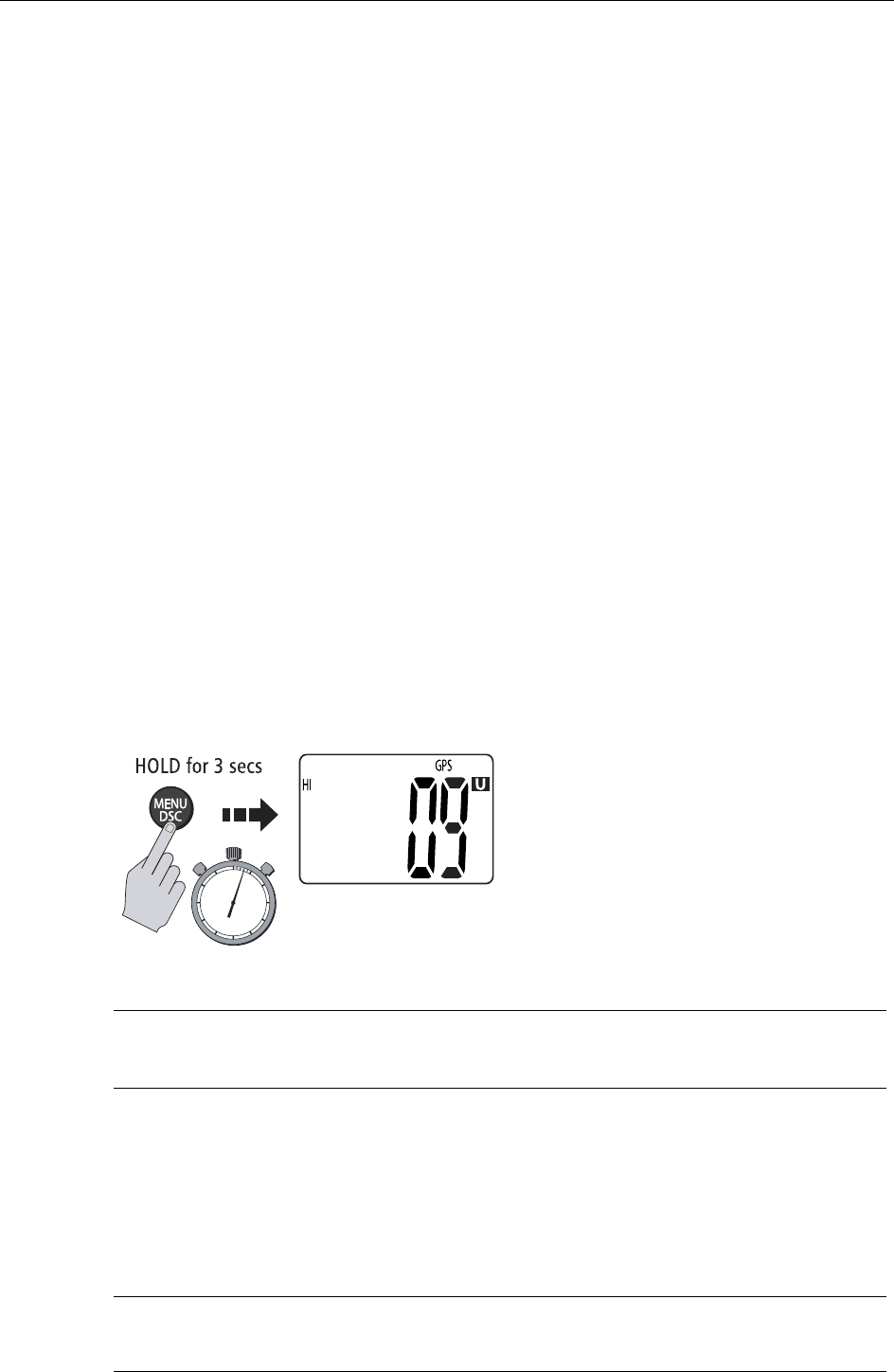
57
Chapter 5: Digital Selective Calling (DSC)
The Ray49 includes equipment for Class “D” Digital Selective Calling (DSC). DSC
protocol is a globally applied system used to send and receive digital calls. DSC
uses a unique Maritime Mobile Service Identity (MMSI) number to direct DSC calls
directly to your radio, much like a telephone number.
Note:
An MMSI number is required to operate the DSC equipment in this radio. You can
obtain an MMSI from BoatUS (www.boatus.com). Once obtained, you can program the
MMSI number yourself one time only using the operation described in “My MMSI ID“ on
page 81. Otherwise, your Raymarine dealer can program or change the number for you.
The Ray49 includes a separate dedicated receiver just for DSC communications on
channel 70. When a DSC call is received, the radio automatically responds based
on the type of call. When receiving a DSC call from another vessel or a coast
station, an alert sounds and DSC data appears in the LCD–such as time of a call,
the caller and the type and priority of a call.
5.1 DSC Call Menu
You access DSC functions via the DSC menu. Press and hold the MENU/DSC key
for 3 seconds to enter DSC call mode.
Note:
Distress calls are made using the DISTRESS key.
The Ray49 can make the following type of DSC calls:
DSC Call
Type Description
DISTRESS Sends out your MMSI number, the nature of your Distress, and the
position and time information currently displayed. This information is
from NMEA data, if available, or the position data you have entered
manually. This digital information lets other ships and shore stations
equipped with appropriate DSC equipment know where you are and
that you are in a Distress situation. Distress Calls are made using the
DISTRESS key.
INDIVIDUAL Makes a ROUTINE DSC call to a specific station identified by its MMSI
number.
D10165-1
10
15
20
25
30
35
40
45
50
55 60 5
DSC MENU
>INDIVIDUAL
GROUP
ALL SHIPS
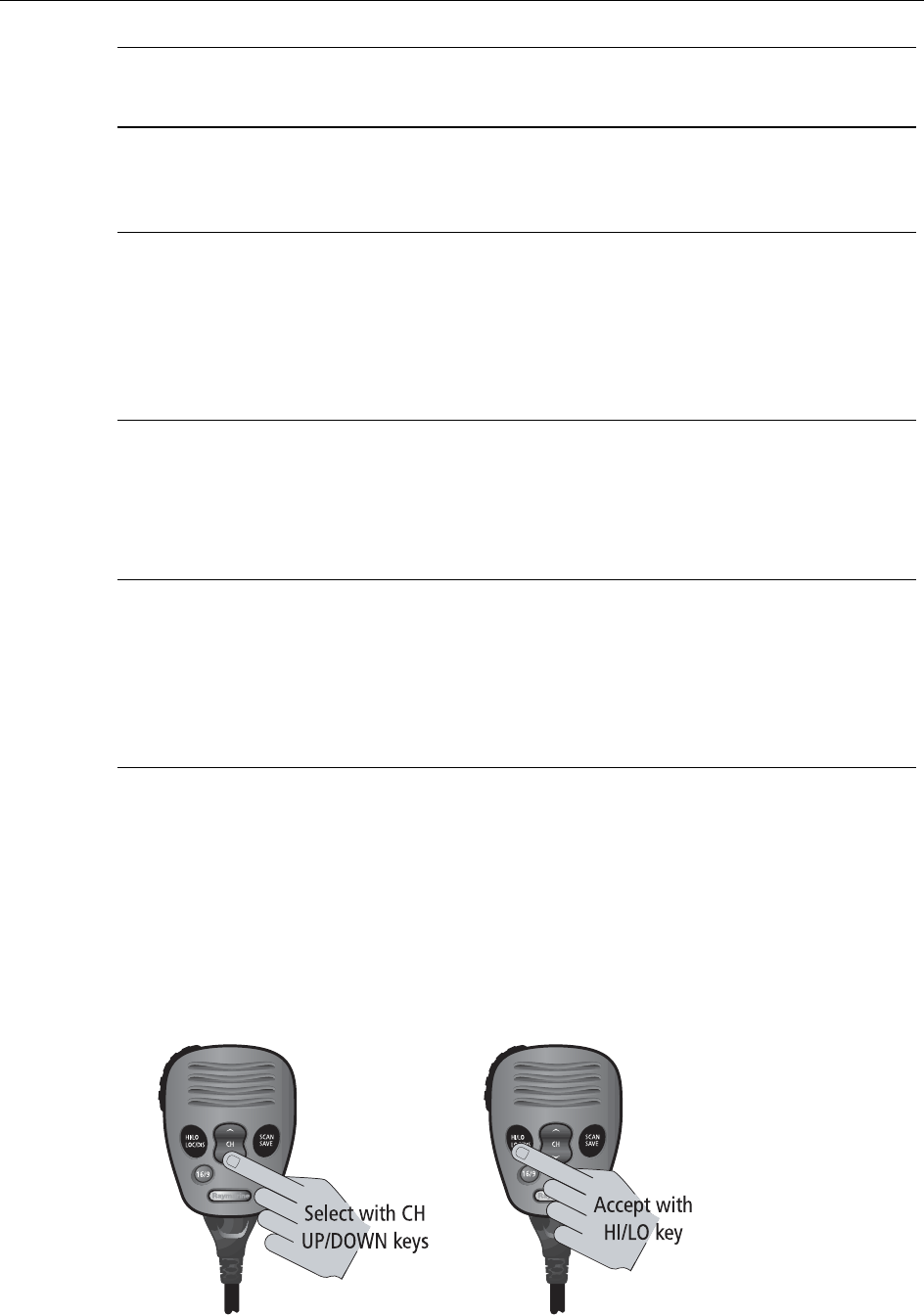
58 Ray49 Marine VHF Radio
Making DSC Menu and Programming Selections
There are two ways to make DSC menu and character selections in your radio:
1. Most examples in this chapter describe making selections using the CH/OK
knob on the transceiver.
2. However, you can also press the microphone up/down keys to make your
selections and then press the microphone HI/LO key to accept.
GROUP Sends transmissions that are only received by radios sharing a com-
mon Group MMSI number. Up to 3 Group MMSI numbers can be
stored and called.
ALL SHIPS Sends out a message to all stations within range that you have impor-
tant information but the situation is not serious enough for a Distress
Call. All Ships calls should only be used if hailing for assistance on
channel 16 fails. There are two types of All Ships Calls: SAFETY for
advisory alerts and URGENCY for assistance when life is not in imme-
diate danger.
POSITION
REQUEST
This option enables you to request GPS position information from any
vessel for which an MMSI number is known. You can specify the target
vessel either by selecting it from your MMSI phonebook or by manu-
ally entering its MMSI number. You can also be requested to send out
your position to someone else.
RECEIVED
CALLS
Three separate logs listing all received DSC Call types by number and
time of call. Entries are separated into the following: Distress Log, Call
Log for all other types of DSC Calls, and Position Log.
NOTE: You can place a call directly from a log to the station that is cur-
rently displayed. You can also add the displayed station to the DSC
Phonebook.
DSC Call
Type Description
D10023-1
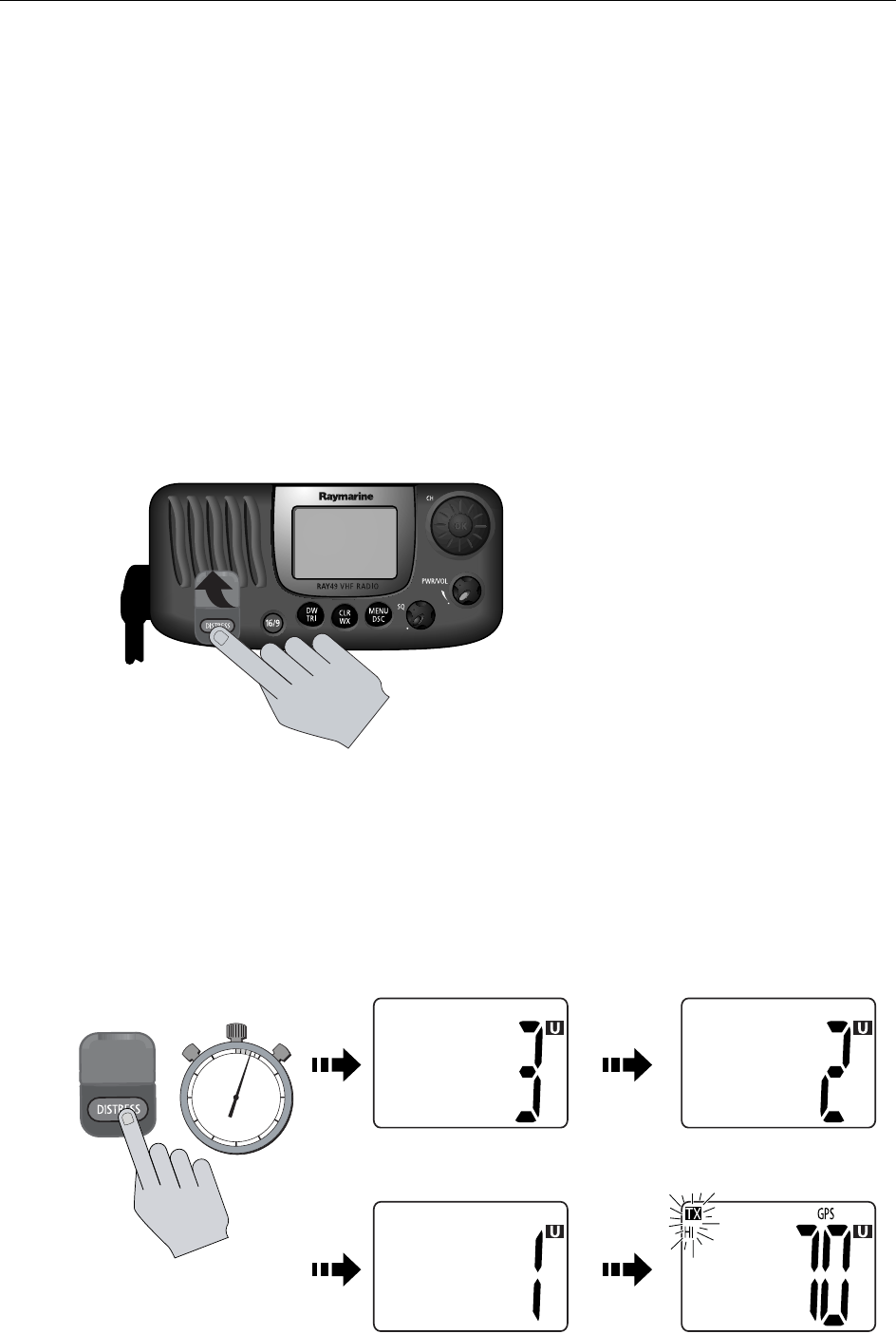
Chapter 5: Digital Selective Calling (DSC) 59
5.2 Distress Calls
For a Distress Call transmission, the Ray49 takes the position and time
information (either from NMEA or manually input) along with your MMSI and
converts it into a digital “packet”. When transmitted, this digital information lets
other ships and shore stations equipped with appropriate DSC equipment know
where you are and that you are in a Distress situation.
Your call can specify the nature of the Distress (designated call) or not
(undesignated call).
Sending a Distress Call
Lift the spring-loaded door on the front panel of the transceiver.
Undesignated (Quick) Distress Call
To send a distress call without specifying its nature:
• Press and hold the red DISTRESS key for 3 seconds to initiate the call. During
this time, the radio beeps, the display flashes and a timer counts down
03...02...01.
D10166-1
D10168-1
PRESS and HOLD for 3 SECS
10
15
20
25
30
35
40
45
50
55 60 5
DISTRES CALL
COUNTING
DOWN...
DISTRES CALL
COUNTING
DOWN...
DISTRES CALL
COUNTING
DOWN...
DISTRES CALL
TRANSMITTING
DISTRESS
UNDESIGNATED
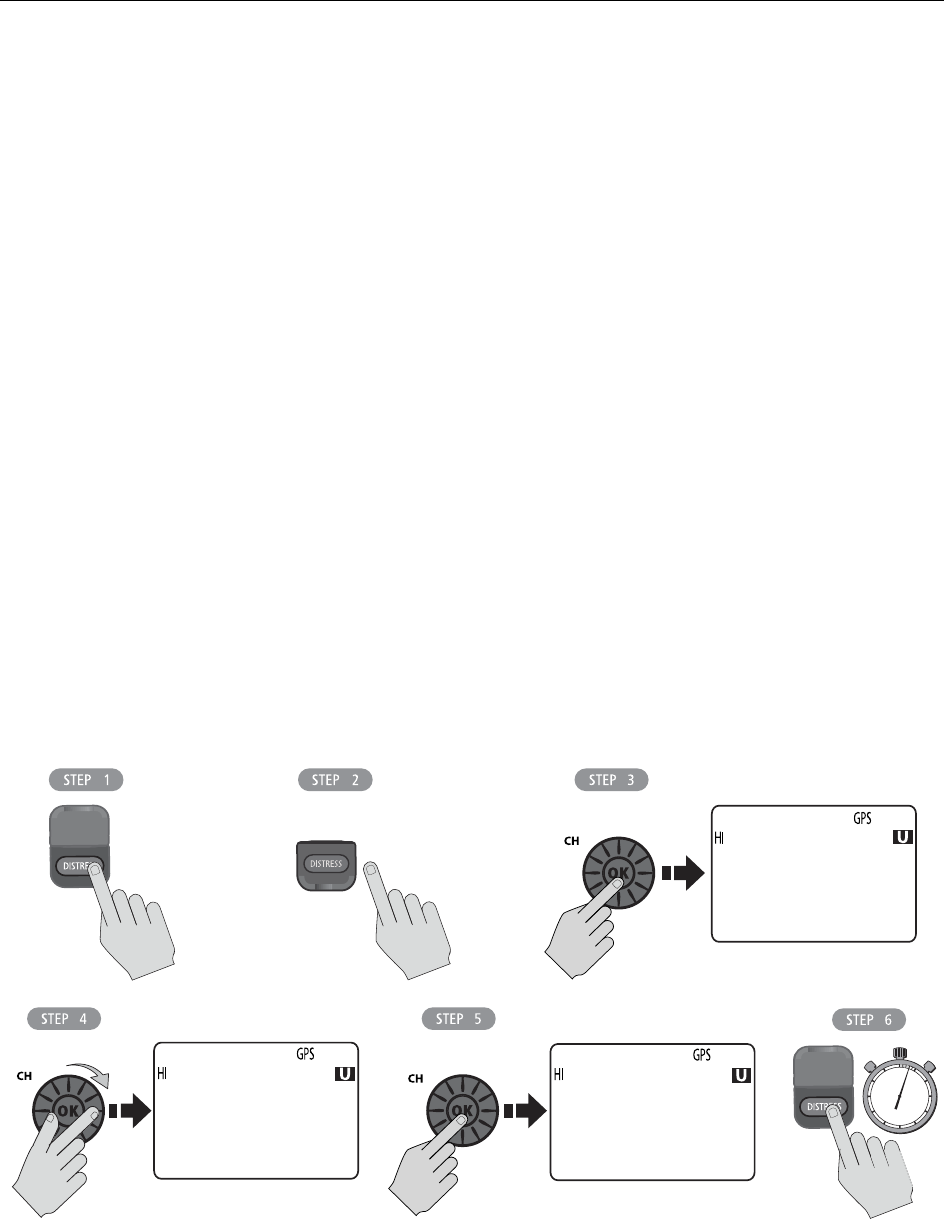
60 Ray49 Marine VHF Radio
Designated Distress Call
To send a distress call and specify its nature:
1. Press the red DISTRESS key.
2. Release the DISTRESS key.
The Distress Call screen appears.
3. Rotate the CH/OK knob until the type of Distress you wish to designate is
highlighted:
4. Press the CH/OK knob to choose that type of Distress.
5. Press and hold the DISTRESS key for 3 seconds to initiate the call. During this
time, the radio beeps, the display flashes and a timer counts down
03...02...01... , just as with the Undesignated Distress Call illustrated above.
• UNDESIG(NATED) • SINKING
• FIRE • ADRIFT
• FLOODING • ABANDONING
• COLLISION • PIRACY
• GROUNDING • MANOVERBD
• LISTING • EXIT
D10167-1
Release
Press
10
15
20
25
30
35
40
45
50
55 60 5
HOLD 3 SECS
PRESS and
DISTRES CALL
>UNDESIG
FIRE
FLOODING
16
16
DISTRES CALL
UNDESIG
FIRE
>FLOODING
16
DISTRES CALL
>FLOODING
HOLD DISTRES
3 SECONDS
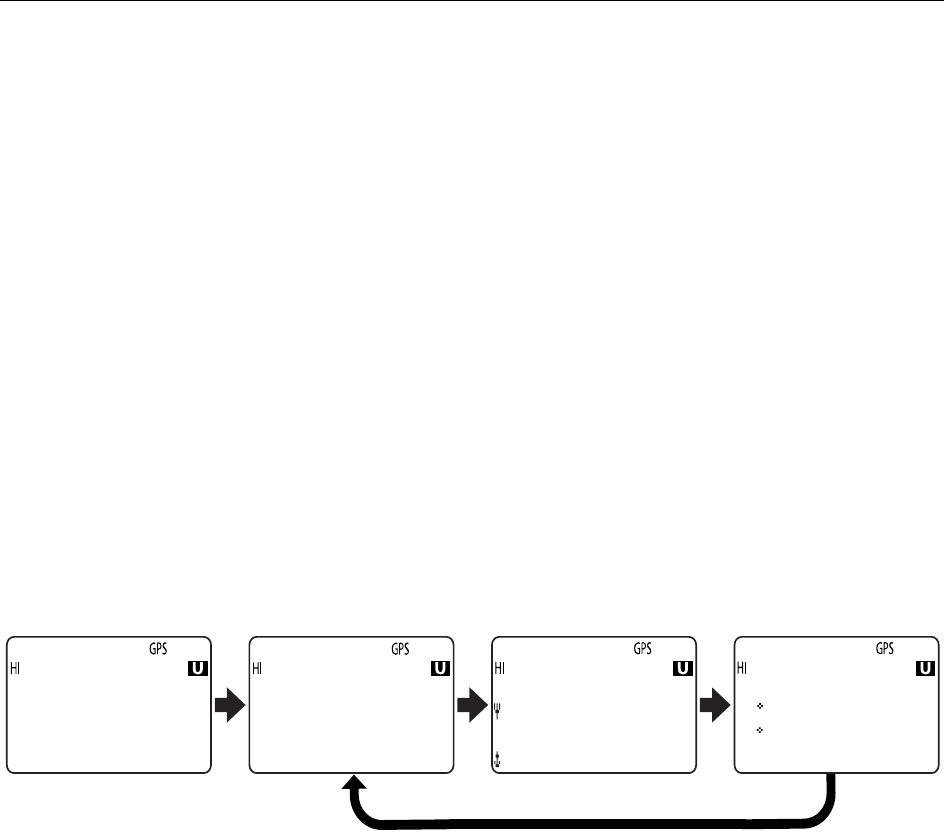
Chapter 5: Digital Selective Calling (DSC) 61
Transmitting
After the Distress transmission, the radio is automatically set to channel 16 at
high power to listen for and respond to voice replies from Coast Guard or other
vessels that may have received your Distress Call.
To mute the alarm:
Press CLR/WX.
To manually cancel the automatic Distress resend:
Press CLR/WX a second time.
The Distress Call is resent randomly every 3.5 – 4.5 minutes until an
acknowledgement is received or the call is manually cancelled.
Receiving Acknowledgement
After the call is sent, the radio waits for acknowledgement. The display stops
flashing and the alarm sounds continuously until muted or an ACK is received.
Cancelling a Distress Call Made in Error
If the countdown has not been completed, release the DISTRESS key before the
countdown has completed.
If the countdown has completed and the distress call has been sent in error, you
should make an announcement as soon as possible that the distress situation
does not exist.
1. Immediately press CLR/WX two times to cancel the Distress Call. The radio
returns to the state before the Distress Call.
2. Press the 16/9 key. The radio switches to the Priority Channel.
3. Make a broadcast to all stations giving your ship’s name, call sign and MMSI
number and cancel the false distress alert. For example:
“All Stations, All Stations, All Stations. This is NAME, CALL SIGN, MMSI ID,
POSITION. Cancel my distress alert of DATE, TIME, NAME, CALL SIGN.”
D10169-1
REPEATS
16
DISTRES ACK
RECEIVED
16
FROM:
001234567
ORIGINATOR:
366123456
16
FLOODING
26 06.0098N
080 04.8589W
12:45UTC
16
DISTRES CALL
AWAIT ACK
AUTO
TRANSMIT

62 Ray49 Marine VHF Radio
Receiving a Distress Call
The Ray49 receives distress messages sent by another vessel and/or
acknowledgments (ACK) sent by a coast station to another vessel in distress. The
radio also receives distress relays.
Note:
Class “D” DSC radios such as the Ray49 are forbidden by law from automatically
acknowledging or relaying DSC distress calls. Upon receiving a distress call, you may hail
the vessel in distress on channel 16 and standby to lend assistance if requested.
When a Distress Call is received, the Ray49 automatically tunes to channel 16 and
sounds the Distress Alarm Tone. (If you have disabled automatic channel
changing, as described on page 84, you are first prompted whether to accept the
call.)
Two alternating screens appear in the display. When position data and time is
included within the signal, it is displayed on the first screen in the text area of the
LCD. The second screen shows the nature of the distress and time it was sent.
The 2 alternating pages of data are recorded in the Distress Log. The envelope
icon ( ) blinks until you accept the call, reject the call, or open the resulting
unread message stored in the Log. See page “Received Calls (Logs)“ on page 79.
To merely mute the alert tone:
Press CLR/WX.
To ignore the Distress Call:
Press CLR/WX a second time. The envelope icon disappears, the call is
interrupted, the radio declines the channel change and returns to normal
operation.
To accept a Distress Call when Auto Channel Change is OFF
1. Press the CH/OK knob. The alert tone is muted, the envelope icon disappears
and the radio accepts the channel change and switches to channel 16.
2. Press CH/OK again to clear the message that the channel has been changed.
Press PTT to communicate on channel 16.
To accept a Distress Call when Auto Channel Change is ON
Press CH/OK. The alert tone is muted, the envelope icon disappears and the radio
automatically switches to channel 16. Press PTT to communicate.
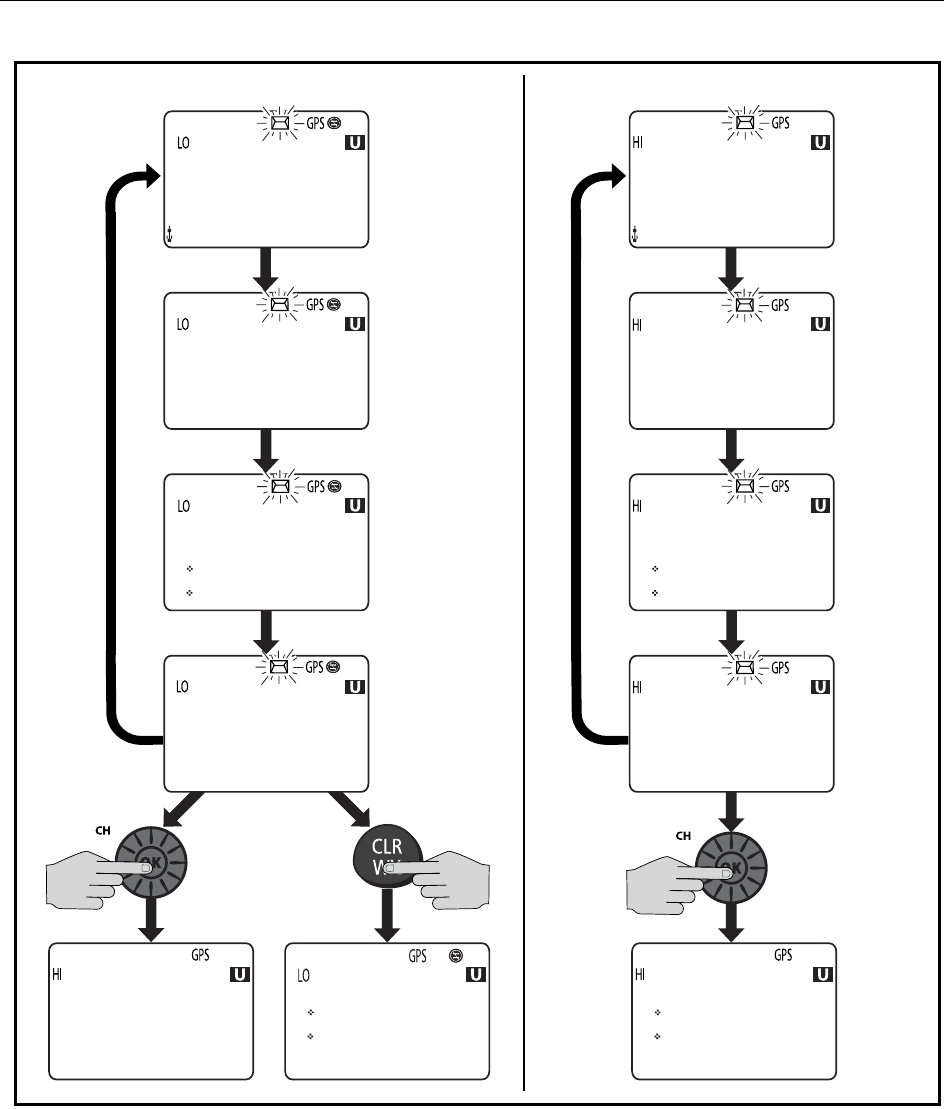
Chapter 5: Digital Selective Calling (DSC) 63
Note:
The AUTO CH CHG option determines whether you want your radio automatically
switched to channel 16 to receive the call or instead to be prompted to manually receive
or decline the channel change. See page 84.
Receiving a Distress Relay Sent by Another Station
When a Distress Relay is received, an alarm sounds, the envelope icon blinks, and
the LCD displays two alternating screens. Page 1 displays the Name/MMSI ID of the
station sending the message. Page 2 displays the Name/MMSI ID of the vessel in
distress and its lat/lon position. The radio does not resend distress relay messages.
...with Auto Channel Change OFF
72
SHIP/SHIP
27 12.1297N
079 24.4544W
PM12:44LOC
D10170-1
...with Auto Channel Change ON
72
DISTRESS
CH CHANGE
REQ TO CH16
72
DISTRESS
FIRE
26 06.0098N
080 04.8589W
72
DISTRESS
12:34UTC
PRESS [OK] OR
PRESS [CLR]
72
DISTRESS
FROM:
366123456
16
DISTRESS
FROM:
366123456
16
DISTRESS
CH HAS BEEN
CHANGED
PRESS [OK]
16
DISTRESS
CH HAS BEEN
CHANGED
16
DISTRESS
FIRE
26 06.0098N
080 04.8589W
16
DISTRESS
12:34UTC
PRESS [OK]
16
DISTRESS
27 12.1297N
079 24.4544W
PM12:44LOC
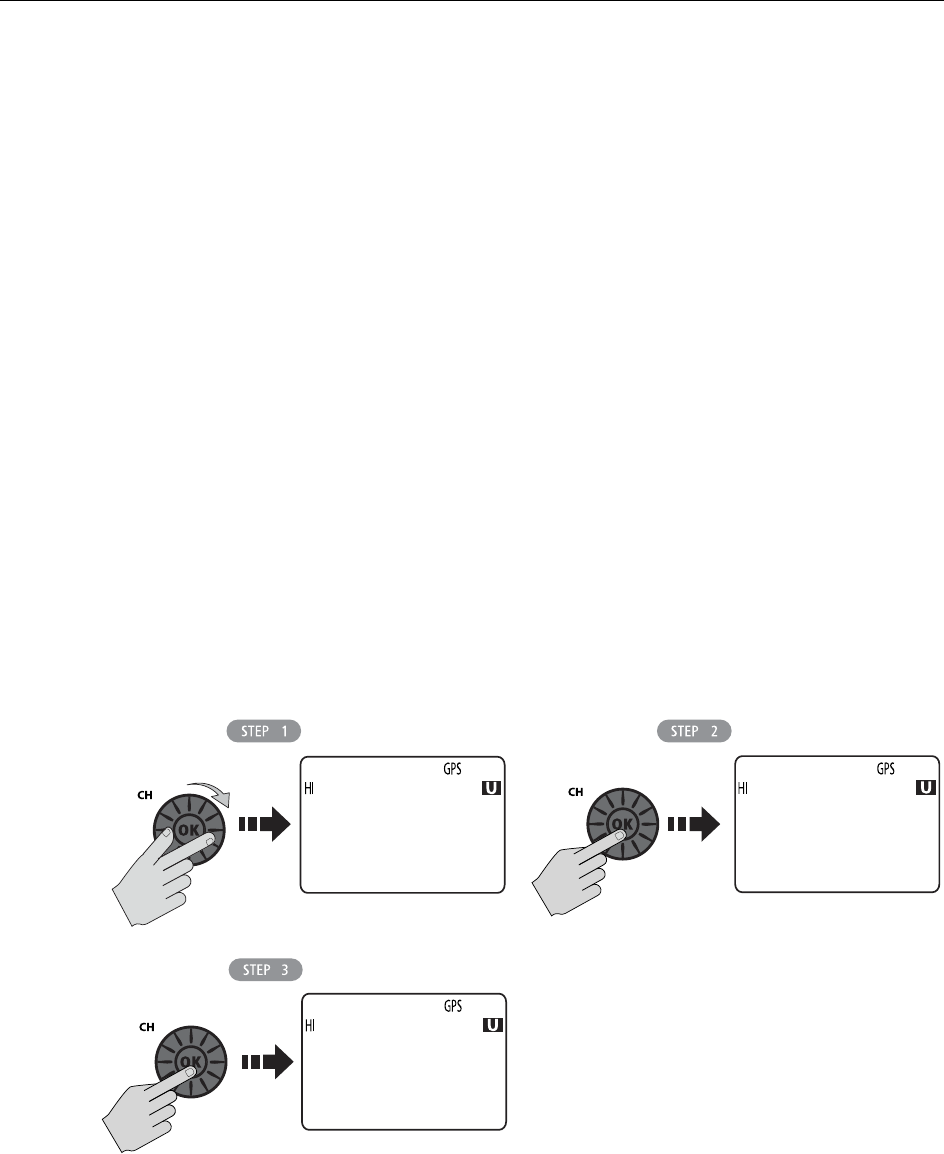
64 Ray49 Marine VHF Radio
5.3 DSC Phonebook
The Phonebook stores up to 31 preprogrammed MMSI numbers that you can
select for making an Individual Call. The numbers are stored by name and contain
the station’s MMSI number. You can add, edit and delete entries from the
Phonebook, much as you would on a cellular telephone. The NAME field can be up
to 10 alpha-numeric characters (all capitals) in length. 13 symbols are also
available. Rotate the CH/OK knob to make an item appear on the dot matrix
display and then press in CH/OK to select that item.
Adding a new Entry
1. From the DSC menu, rotate the CH/OK knob until the arrow points to PHONE-
BOOK.
2. Press in the CH/OK knob to select.
The list of Phonebook entries appears. The arrow is pointing to <NEW>. If no
entries have yet been entered, this is your only choice.
3. Press the CH/OK knob again to select. You are prompted to enter the MMSI
number for the new entry. The first character space to be modified is high-
lighted with a flashing underline.
4. Rotate the CH/OK knob. The flashing underline is replaced with a numeric
character. Continue rotating the knob to scroll through the selections.
5. When the appropriate number appears, press the CH/OK knob to accept. The
next character to be filled in sequence is then underlined.
D10227-1
DSC MENU
POS REQUEST
RECV'D CALL
>PHONEBOOK
16
16
ENTER MMSI:
_--------
ENTER NAME:
-----------
PHONEBOOK
>[NEW]
[BACK]
16
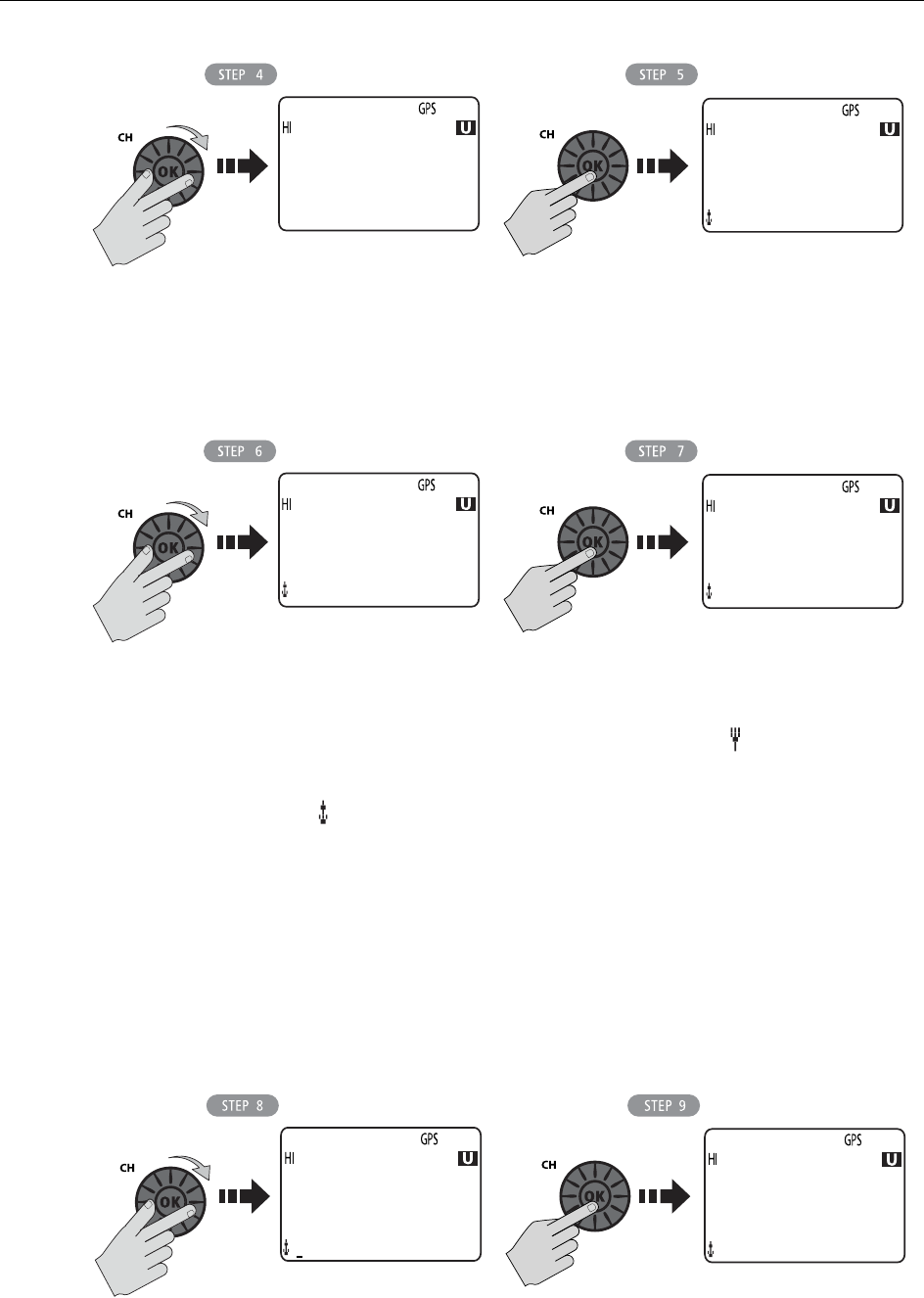
Chapter 5: Digital Selective Calling (DSC) 65
6. Continue this process until all MMSI digits have been entered.
7. When you press CH/OK to accept the final MSSI ID digit, the cursor moves on
to the NAME field. The first character in this line is a symbol assigned by the
radio, based on the MMSI number you entered.
Coast Stations are identified by “00” at the beginning of the station name. If
you enter 00 as the leading digits of the MMSI ID, the radio recognizes this as
a coast station and automatically enters a tower symbol ( ).
If you enter a number other than 0 in the initial position of the MMSI ID, an
anchor symbol ( ) is entered as a prefix to the name, identifying this as a Ship
Station.
8. The first character space to be modified is highlighted with a flashing under-
line. Using the same procedure as above, rotate the CH/OK knob to select the
NAME characters. All alpha and numeric characters are available, as well as
13 symbols: ! # % ’ ( ) : ? / . , + -
9. Press CH/OK to accept. Continue this process until all NAME characters have
been entered.
10. When complete, press CH/OK to accept.
11. Press CH/OK again to SAVE. The new entry appears in the list.
D10228-1
16
ENTER MMSI:
3--------
ENTER NAME:
-----------
16
ENTER MMSI:
3_-------
ENTER NAME:
-----------
D10229-1
16
ENTER MMSI:
366123456
ENTER NAME:
-----------
16
ENTER MMSI:
366123456
ENTER NAME:
_----------
D10230-1
16
ENTER MMSI:
366123456
ENTER NAME:
T ---------
16
ENTER MMSI:
366123456
ENTER NAME:
TOTL MADNE_

66 Ray49 Marine VHF Radio
Editing an Existing Entry
1. From the Phonebook, rotate the CH/OK knob until the arrow is pointing to the
entry you wish to edit.
2. Press CH/OK. The list of options appear.
3. Rotate the CH/OK knob until the arrow is pointing to EDIT
4. Press CH/OK to select.
5. Make your changes to the NAME and MMSI ID, using CH/OK.
6. When finished, press CH/OK to save your changes. The revised name or MMSI
number appears in the list.
Deleting an Existing Entry
1. From the Phonebook, rotate the CH/OK knob until the arrow is pointing to the
entry you wish to edit.
2. Press CH/OK. The list of options appear.
3. Rotate the CH/OK knob until the arrow is pointing to DELETE.
4. Press CH/OK to confirm your selection.The entry is removed from the list.
5.4 Individual Calls
The Ray49 can make Individual Routine calls.
Making DSC Calls to Coast Stations
The examples in this handbook illustrate making DSC calls to Ship Stations.
However, the procedures for making Individual Calls to a Coast Station are
different. Calls to a Ship Station require that you enter a subsequent working
channel chosen from a pre-programmed list offered to you by the Ray49. Calls to
a Coast Station remove this step from the operating procedures. The Coast
Station controls and indicates the subsequent working channel within its
acknowledgement.
D10231-1
16
366123456
TOTL MADNES
>SAVE
CANCEL
16
PHONEBOOK
[NEW]
> TOTL MADNES
[BACK]
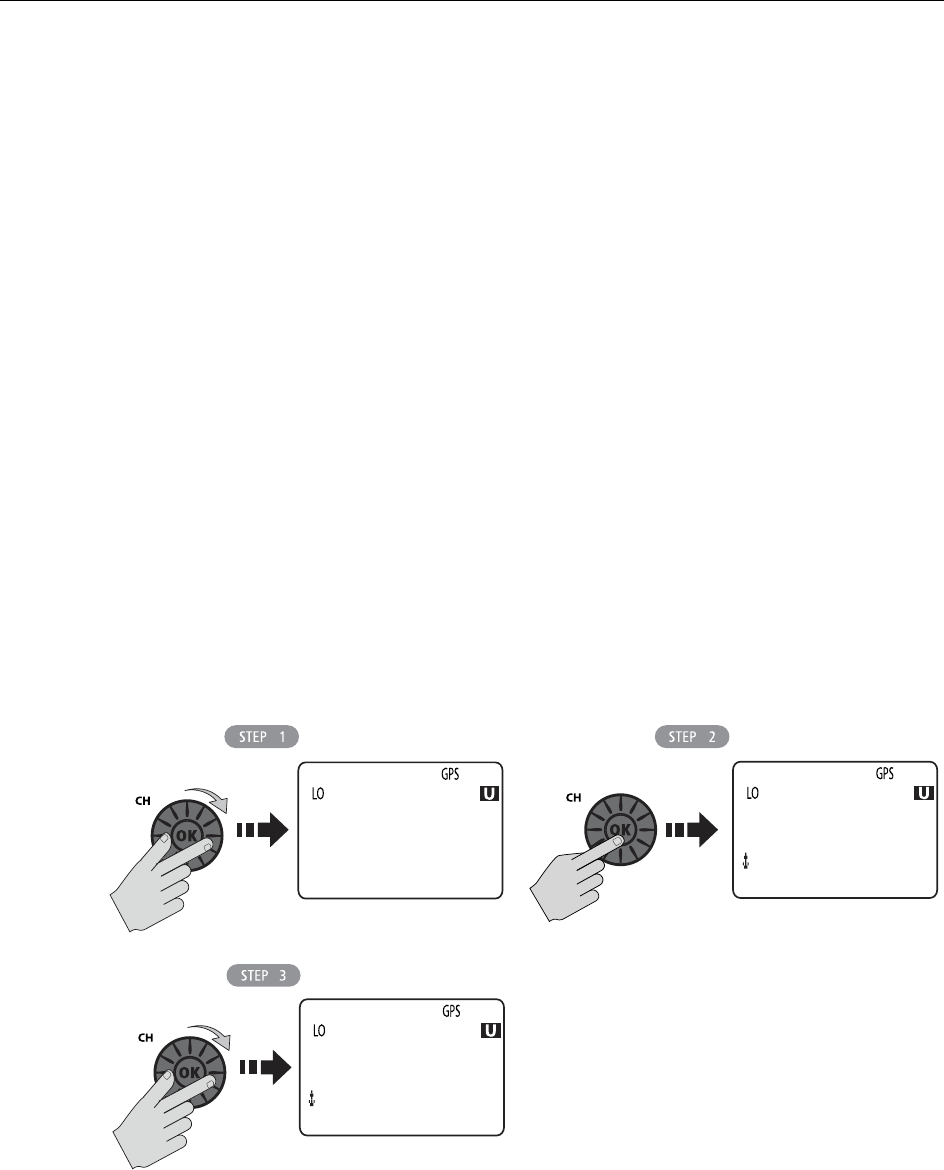
Chapter 5: Digital Selective Calling (DSC) 67
The Ray49 automatically detects the correct procedures for you based on the type
of MMSI number you enter manually or with or the phonebook. If “00” is
detected as the first two characters of the MMSI, Coast Station procedures are
implemented automatically.
Note:
When making a call to a coast station, you will not be asked to select a working
channel because that will be provided by the coast station.
Transmitting an Individual Call
To make an Individual Call to a ship or coast station, you must select the specific
MMSI number to contact and the working channel to be used for the call. The
MMSI ID can be entered manually or selected from a Phonebook list of
preprogrammed numbers specified using the MENU function, as follows:
1. From the DSC menu, rotate the CH/OK knob until the arrow points to INDI-
VIDUAL.
2. Press CH/OK. The Individual Routine menu appears, which displays any
Phonebook entries you have saved and <MANUAL> for manual number
entry.
3. Rotate the CH/OK knob until the arrow points to the desired individual name.
If using MANUAL MMSI ID entry:
Enter the MMSI number using the CH/OK knob. Rotate CH/OK to select each
character and then press in to accept. The next position to be modified is indi-
cated by a blinking underline. A more-detailed description of manual charac-
ter entry can be found in
“Adding a new Entry“ on page 64
.
D10171-1
DSC MENU
>INDIVIDUAL
GROUP
ALL SHIPS
72
72
IND ROUTINE
MANUAL
> TOTL MADNES
[BACK]
72
IND ROUTINE
>MANUAL
TOTL MADNES
[BACK]
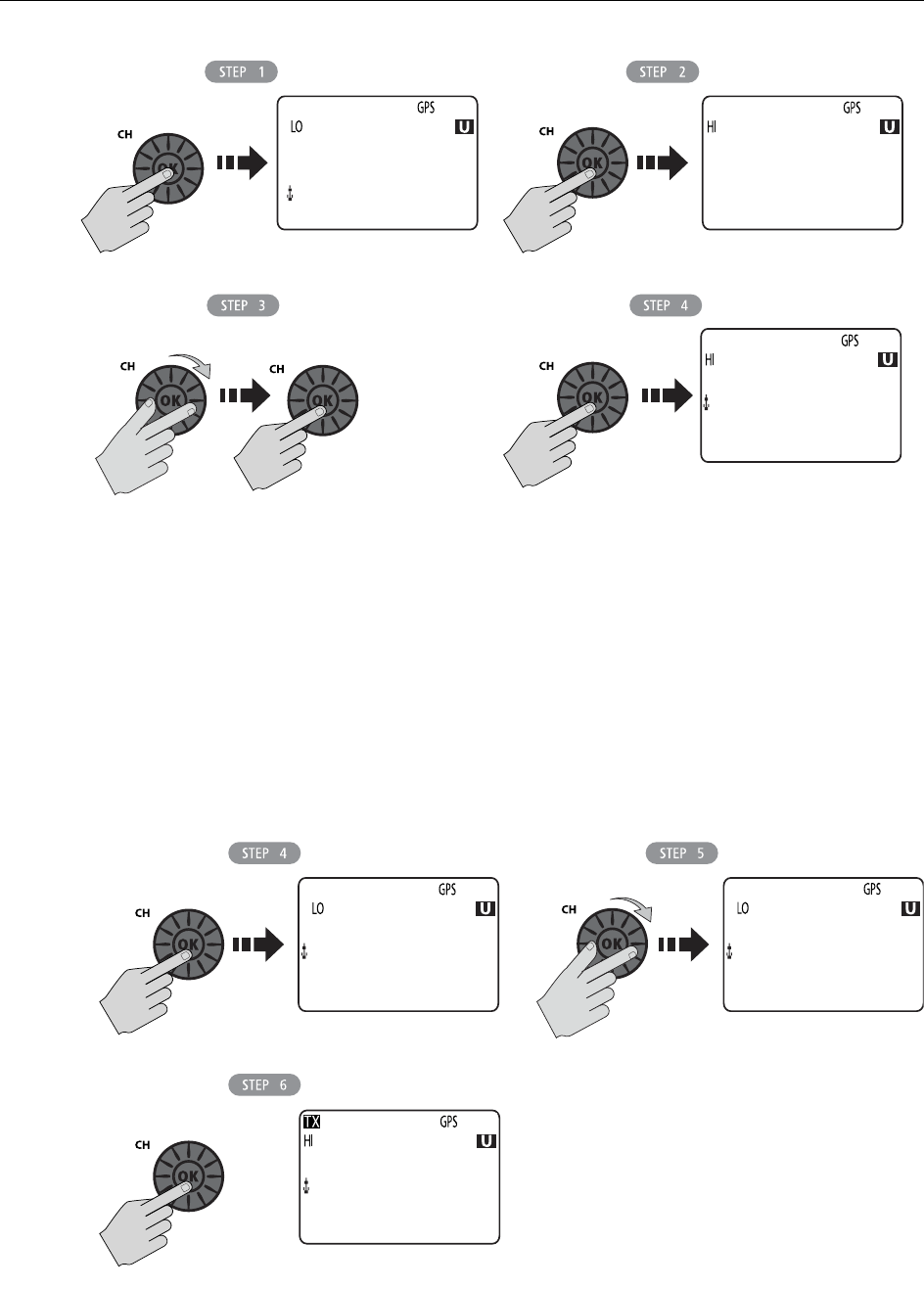
68 Ray49 Marine VHF Radio
4. When the desired name is highlighted, press SELECT.
5. Rotate the CH/OK knob to select the working channel to be used for the Indi-
vidual Call and then press in CH/OK to accept. Select from 06, 08, 09, 10, 13,
16, 17, 67, 68, 69, 71, 72, 73 or 77.
Note:
Individual Calls to a Coast Station remove this step from the operating proce-
dures. The Coast Station controls and indicates the working channel within its ACK.
6. Press CH/OK to transmit the call. The Individual Call is transmitted on channel
70, the radio tunes to the original channel and waits for acknowledgement.
During this period you are still able to receive calls.
7. When the acknowledgement is received, the radio automatically switches to
the selected working channel and sounds a DSC Call alert ring. Press CH/OK
to confirm.
D10232-1
72
IND ROUTINE
366123654
CALLING...
IND ROUTINE
ENTER MMSI:
_--------
7272
IND ROUTINE
>MANUAL
TOTL MADNES
[BACK]
D10172-1
IND ROUTINE
TOTL MADNES
SELECT CH
PRESS [OK]
72 68
IND ROUTINE
TOTL MADNES
SELECT CH
PRESS [OK]
70
IND ROUTINE
TOTL MADNES
CALLING...
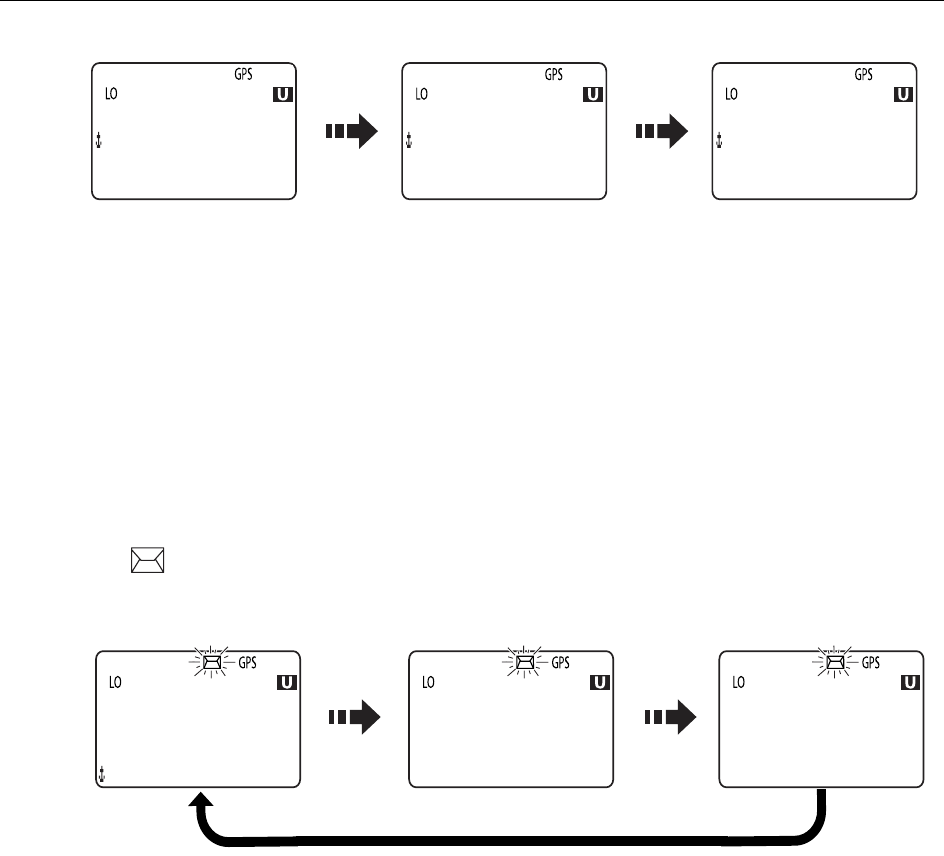
Chapter 5: Digital Selective Calling (DSC) 69
Press PTT to communicate on the specified channel. Pressing PTT at any time
before an ACK is received cancels the Individual Call
Receiving Individual Calls
When an Individual Call is received, an alert tone sounds, the envelope icon blinks
and the LCD alternates among 3 screens displaying the name (or MMSI ID) of the
station initiating the call and that a request for a change of working channels is
being made. The channel does not change until you accept.
The 3 alternating pages of data are recorded in the Call Log. The envelope icon
()blinks until you accept the call, reject the call, or open the resulting unread
message stored in the Log. See page “Received Calls (Logs)“ on page 79.
To mute the alert tone:
Press CLR/WX.Automatic cancellation takes place after 2 minutes.
To ignore the Individual Call:
Press CLR/WX a second time. The envelope icon disappears, the call is interrupted
and the normal screen appears on the LCD.
To accept an Individual Call:
1. Press CH/OK to change channels to the one designated by the caller. The alert
tone is muted and the envelope icon disappears.
2. If the caller requests an acknowledgement, press CH/OK to send.
3. When the caller responds to the ACK, press CH/OK to return to standby mode.
Establish voice communications on the designated channel by pressing PTT.
If the caller requests that you change to an unsupported working channel the
message INVALID CHANNEL appears on the LCD. If an acknowledgement is sent,
the originating station is sent the message UNABLE TO COMPLY, indicating that
your radio could not make the requested channel change.
D10173-1
72
IND ROUTINE
TOTL MADNES
AWAITING ACK
68
ACK RECEIVED
TOTL MADNES
CH HAS BEEN
CHANGED
68
ACK RECEIVED
TOTL MADNES
PRESS [OK]
REPEATS
INDIVIDUAL
ROUTINE
FROM:
GOOD RX
68
INDIVIDUAL
ROUTINE
CH CHANGE
REQ TO CH72
68
INDIVIDUAL
ROUTINE
PRESS OK OR
PRESS CLR
68
D10174-1

70 Ray49 Marine VHF Radio
5.5 Group Calls
The Group Call feature sends transmissions that are only received by radios
sharing a common Group MMSI number, such as a flotilla or racing fleet. The
Ray49 sends Group Routine calls.
Group MMSI Setup
You can program up to three Group MMSI ID numbers. Group MMSI ID numbers
always begin with a zero (0). You only enter the last 8 digits of the Group ID
number; the initial “0” is automatically entered for you.
Adding a New Group
1. From the DSC menu, rotate the CH/OK knob until the arrow points to GROUP.
2. Press CH/OK to select. Group options appear, with the arrow pointing to
CALL.
3. Rotate CH/OK until the arrow points to MY GROUP ID.
4. Press CH/OK to select. If existing Group MMSI ID numbers are already stored,
those values appear. If blank, <EMPTY 1>, <EMPTY 2>, etc. are shown to
indicate that the Group IDs have not yet been programmed.
Select the first available empty group location.
5. Press CH/OK to select. The GROUP MMSI field appears. The initial “0” is
automatically entered for you, indicating that this is a Group MMSI ID. The
first character space that you can modify is highlighted with a flashing under-
line.
6. Fill in the GROUP MMSI fields one number at a time, using the CH/OK knob:
• Rotate to CH/OK display the desired character.
• Press in CH/OK to accept and move on to the next character space.
Repeat this process to fill in all MMSI numbers.
(A more-detailed description of manual character entry can be found in
“Adding a new Entry“ on page 64.)
7. Press CH/OK to accept.
8. When complete, press CH/OK to confirm. The new entry appears in the list.
D10234-1
SEND ACK
ABLE COMPLY
>SEND
CANCEL
68
CH HAS BEEN
CHANGED
PRESS [OK]
72
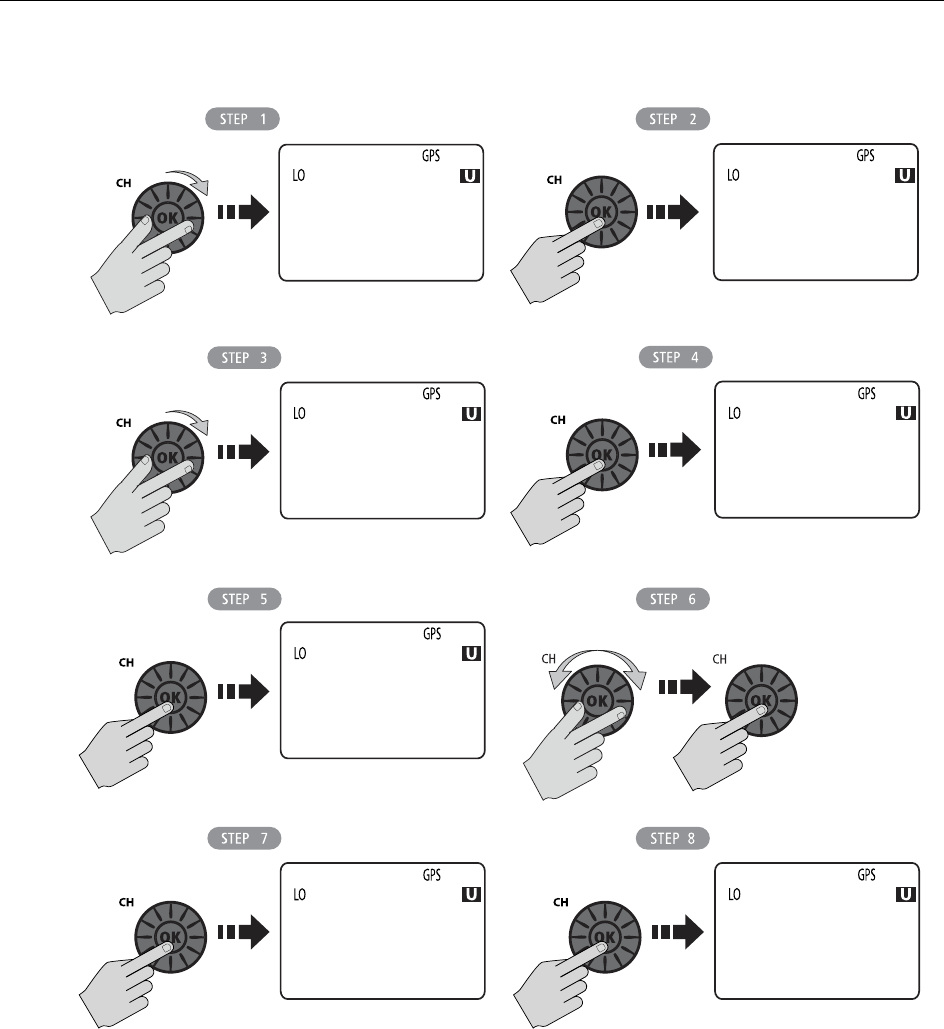
Chapter 5: Digital Selective Calling (DSC) 71
Use the same procedure to edit an existing entry in the list.
Transmitting a Group Call
To call another vessel in the group, select the Group Name to contact from the list
of numbers described in the preceding section and the working channel to be
used for the Group Call.
1. From the DSC menu, rotate the CH/OK knob until the arrow points to GROUP.
2. Press CH/OK to select. Group options appear, with the arrow pointing to
CALL.
3. Press the CH/OK knob to select CALL. The group entries that you have saved
appear. Point to the group name you wish to call.
4. Press CH/OK to select.
D10175-1
Select Characters Press OK
DSC MENU
INDIVIDUAL
>GROUP
ALL SHIPS
09
GROUP
>CALL
MY GROUP ID
[BACK]
09
09
GROUP
CALL
>MY GROUP ID
[BACK]
09
MY GROUP ID
>[EMPTY 1]
[EMPTY 2]
[EMPTY 3]
09
ENTER MMSI:
0_-------
ENTER NAME:
-----------
09
ENTER MMSI:
036612345
ENTER NAME:
RAYMARINE
09
MY GROUP ID
>036612345
[EMPTY 2]
[EMPTY 3]
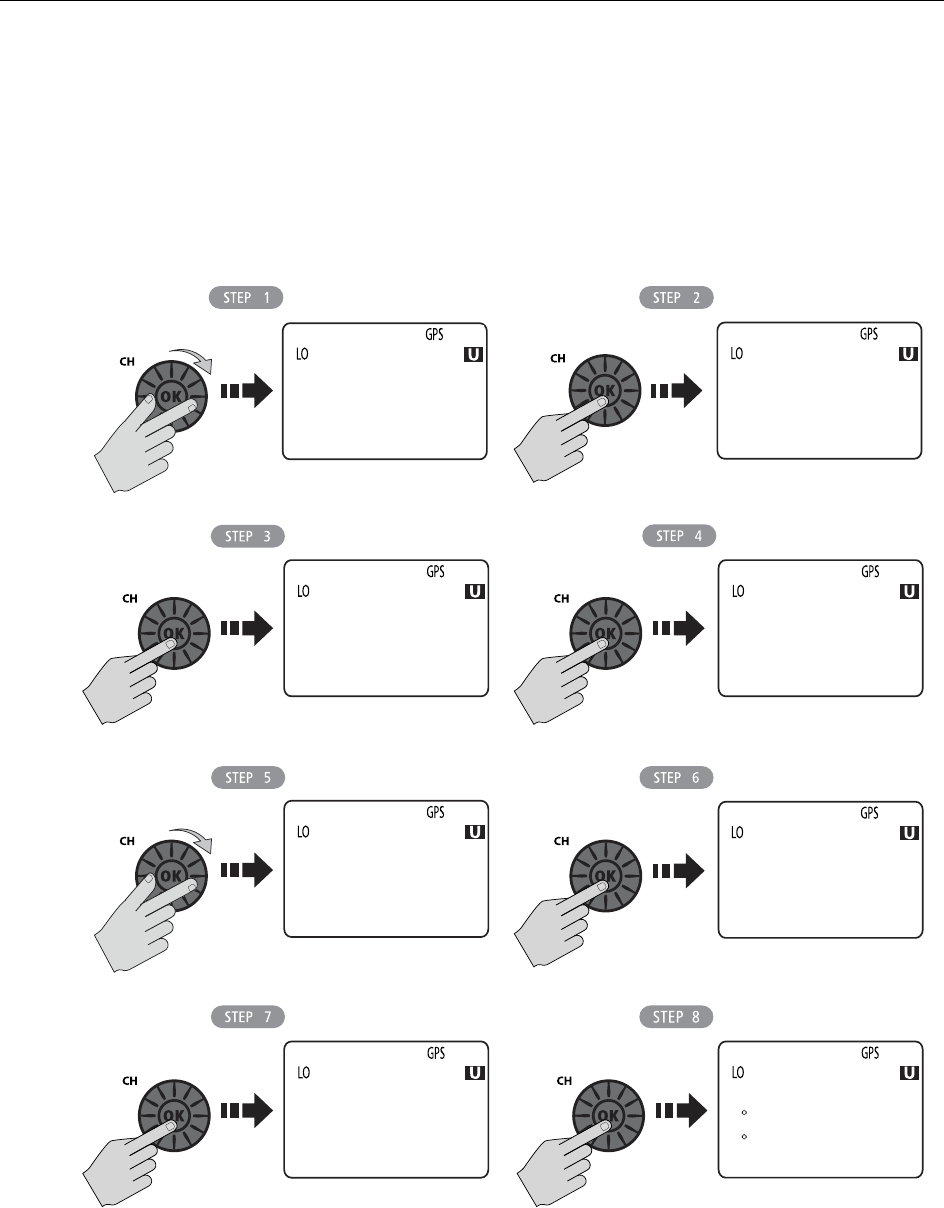
72 Ray49 Marine VHF Radio
5. Rotate CH/OK to select the working channel to be used for the call.
6. Press CH/OK to select. You are prompted to send the call or cancel the call.
7. Press CH/OK to transmit the Group Call.
The Group Call is transmitted on channel 70, and the radio tunes to the desig-
nated working channel to be used for the Group Call.
8. Press CH/OK to confirm and converse on the designated channel.
.
D10176-1
DSC MENU
INDIVIDUAL
>GROUP
ALL SHIPS
69
GROUP
>CALL
MY GROUP ID
[BACK]
69
69
GRP ROUTINE
>036612345
036654321
[EMPTY]
69
GRP ROUTINE
036612345
SELECT CH
PRESS [OK]
72
GRP ROUTINE
036612345
SELECT CH
PRESS [OK]
72
GRP ROUTINE
036612345
>SEND
CANCEL
72
TX COMPLETE
CH HAS BEEN
CHANGED
PRESS [OK]
72
SHIP/SHIP
26 04.2172N
080 09.0933W
AM11:57LOC
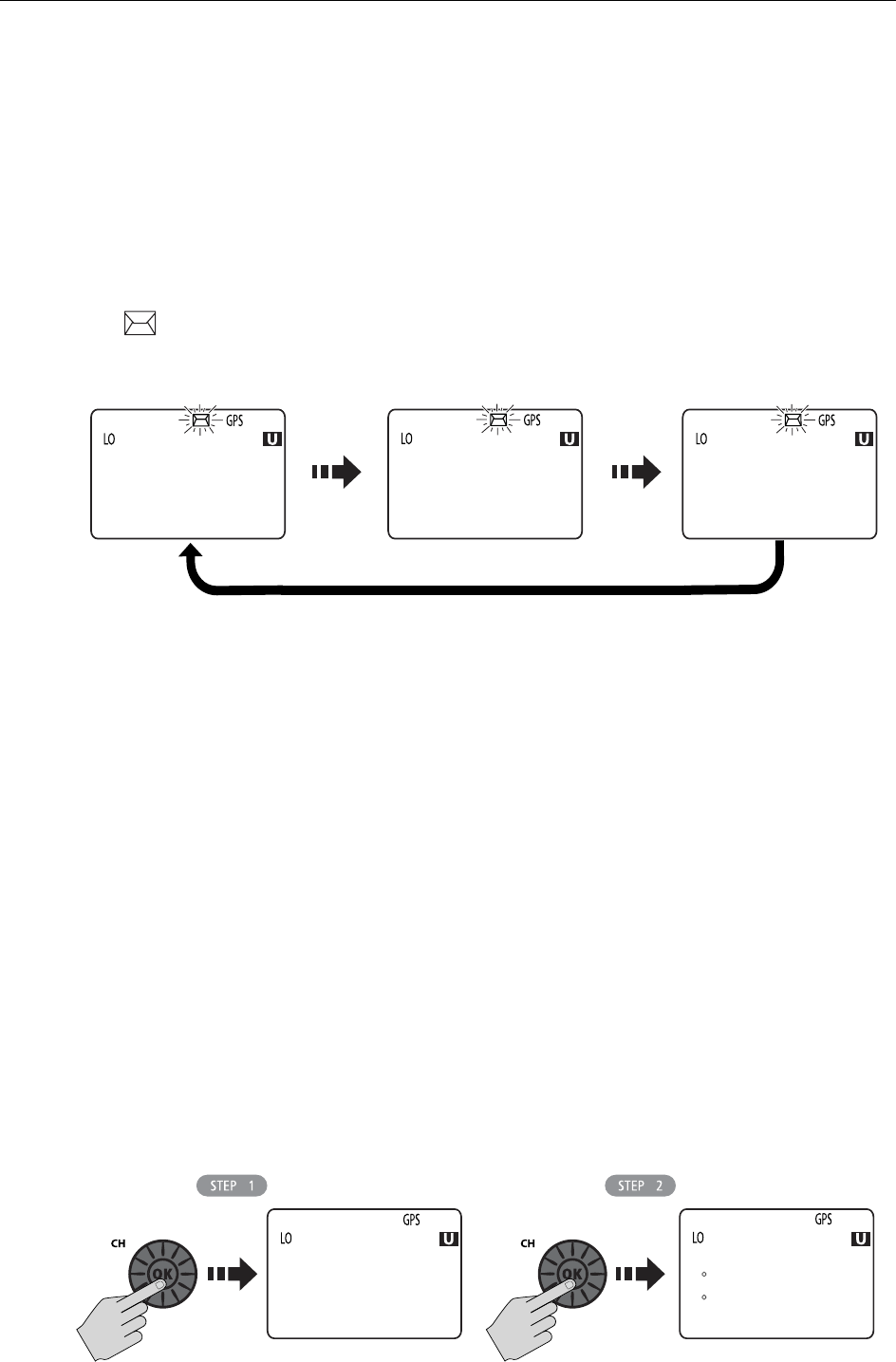
Chapter 5: Digital Selective Calling (DSC) 73
Receiving Group Calls
The Ray49 can receive Group Routine Calls from anyone in your prearranged
group.
When a Group Call is received, the LCD alternates among 3 screens displaying the
or MMSI ID of the station in the group initiating the call and that a request for a
change of working channels is being made.
The 3 alternating pages of data are recorded in the Call Log. The envelope icon
()blinks until you accept the call, reject the call, or open the resulting unread
message stored in the Log. See page “Received Calls (Logs)“ on page 79.
To mute the alert tone:
Press CLR/WX.Automatic cancellation takes place after 2 minutes.
To ignore the Group Call:
Press CLR/WX a second time. The envelope icon disappears, the call is interrupted
and the normal screen appears on the LCD.
To accept the Group Call:
1. Press CH/OK to change channels to the one designated by the caller. The alert
tone is muted and the envelope icon disappears.
2. Press CH/OK to return to the standby mode. Establish voice communications
on the designated channel by pressing PTT.
If the caller requests that you change to an unsupported working channel the
message INVALID CHANNEL appears on the LCD. If an acknowledgement is sent,
the originating station is sent the message UNABLE TO COMPLY, indicating that
your radio could not make the requested channel change.
REPEATS
D10177-1
GROUP
ROUTINE
GROUP:
036612345
71
GROUP
ROUTINE
CH CHANGE
REQ TO CH68
71
GROUP
ROUTINE
PRESS OK OR
PRESS CLR
71
D10235-1
68
CH HAS BEEN
CHANGED
PRESS [OK]
68
SHIP/SHIP
26 04.2172N
080 09.0933W
AM11:57LOC
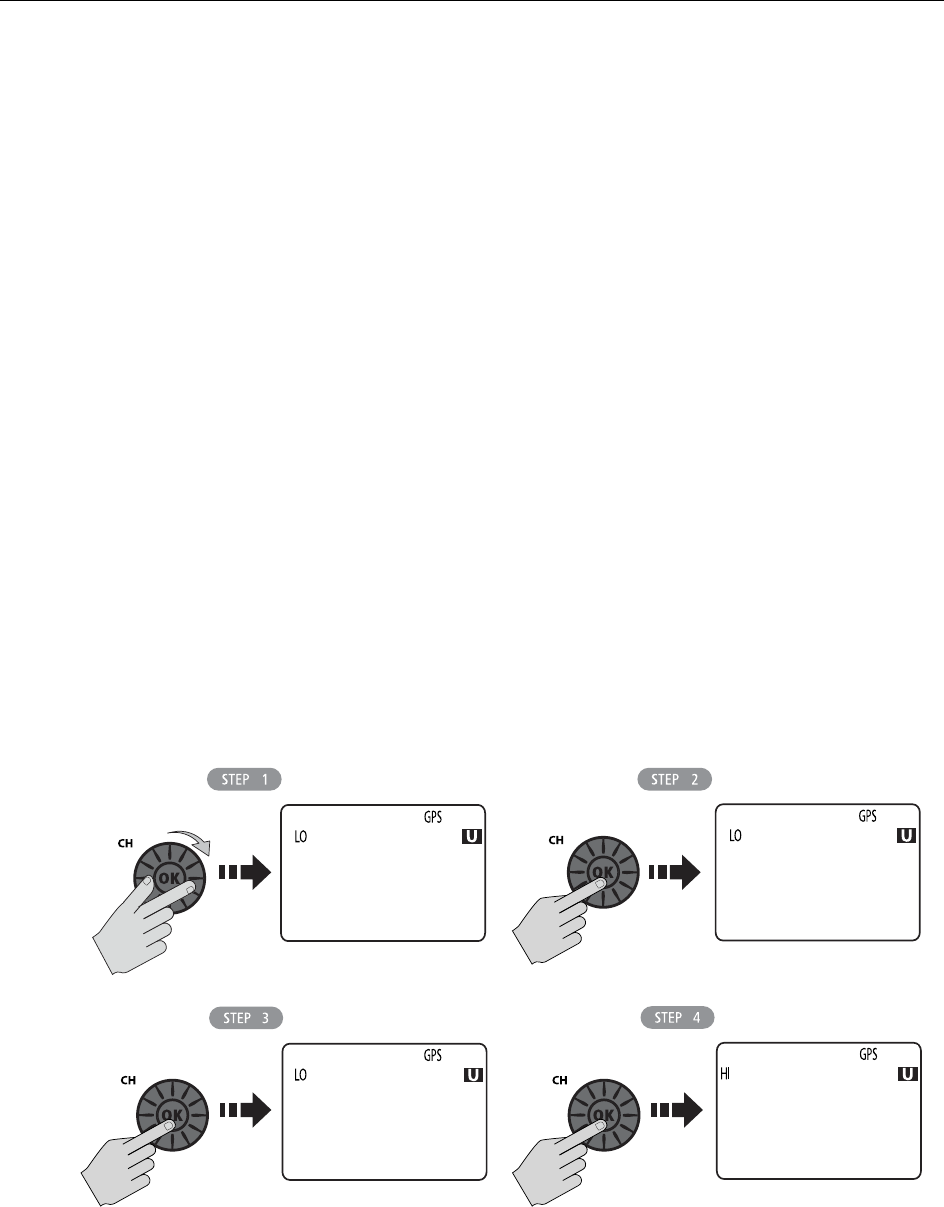
74 Ray49 Marine VHF Radio
5.6 All Ships Calls
An All Ships Call sends out a message to all stations within range. The Ray49 can
make All Ships Safety Calls for advisory alerts and Urgency Calls when assistance
is required but life is not in danger. For example, you might send a Safety Call to
warn others there is a large floating object that may be a hazard to navigation. A
sample Urgency Call might be that you have an illness or an accident on board.
The All Ships Call is made on channel 70, and then the radio automatically
switches to channel 16 at high power for voice communications.
Transmitting an All Ships Call
1. From the DSC menu, rotate the CH/OK knob until the arrow points to ALL
SHIPS.
2. Press CH/OK to select. Choose the type of call you wish to make: URGENCY or
SAFETY.
3. Press CH/OK again to transmit the call. The call is transmitted on channel 70,
and then the radio tunes to channel 16 at high power.
4. Press CH/OK to reconfirm the All Ships Call. The radio returns to standby
mode.
Press PTT to communicate on channel 16.
Receiving an All Ships Call
How the radio processes an incoming All Ships Call depends upon the call’s
priority. Routine and Safety calls have a lower priority than All Ships Urgency and
Distress calls.
D10178-1
DSC MENU
INDIVIDUAL
GROUP
>ALL SHIPS
68
ALL SHIPS
>URGENCY
SAFETY
[BACK]
68
68
ALL SHIPS
URGENCY
>SEND
CANCEL
16
TX COMPLETE
CH HAS BEEN
CHANGED
PRESS [OK]
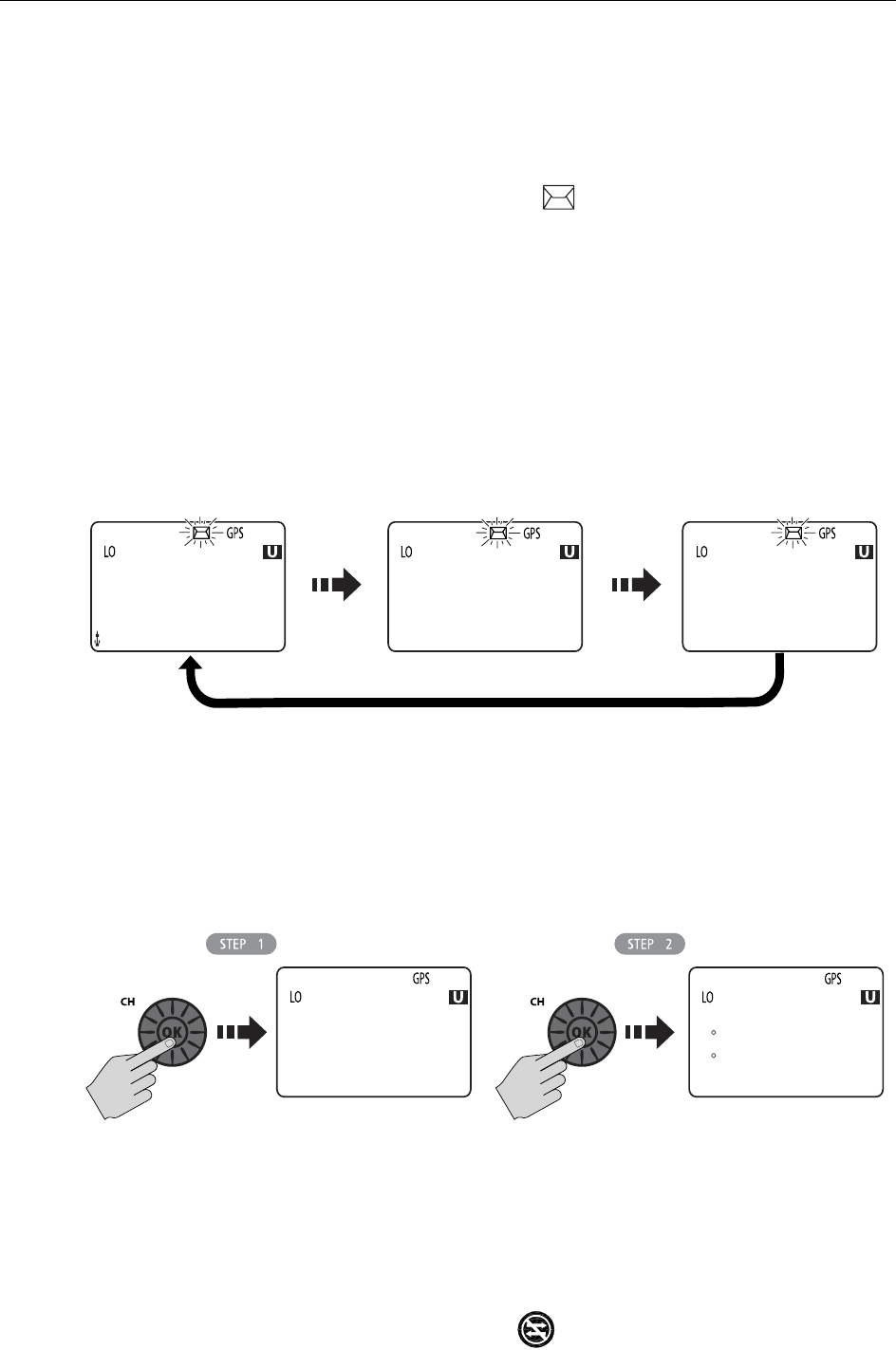
Chapter 5: Digital Selective Calling (DSC) 75
All Ships Routine or Safety
When an All Ships Routine or Safety Call is received, the LCD alternates among 3
screens displaying the name (or MMSI ID) of the station initiating the call and that
a change of channels has been made. The 3 alternating pages of data are
recorded in the Call Log. The envelope icon ( )blinks until you accept the call,
reject the call, or open the resulting unread message stored in the log. See page
“Received Calls (Logs)“ on page 79.
To mute the alert tone:
Press CLR/WX.Automatic cancellation takes place after 2 minutes.
To ignore the All Ships Call:
Press CLR/WXa second time. The envelope icon disappears, the call is interrupted
and the normal screen appears on the LCD.
To accept an All Ships Routine or Safety Call:
1. Press the CH/OK knob. The alert tone is muted, the envelope icon disappears
and the radio switches to channel 16.
2. Press CH/OK again to confirm the channel change. The radio returns to
standby mode. Press PTT to communicate on channel 16.
All Ships Urgency or Distress Call
For an Urgency or Distress Call, the Automatic Channel Change option (see page
84) determines how the call is handled. If set ON, the radio automatically switches
to Priority Channel 16 for voice communications. If OFF, you are prompted to
manually accept or decline the call and channel change by pressing CH/OK or
CLR/WX, respectively. When set OFF, the icon appears.
REPEATS
D10181-1
ALL SHIPS
SAFETY
FROM:
TRANQUILITY
71
ALL SHIPS
SAFETY
CH CHANGE
REQ TO C16
71
ALL SHIPS
SAFETY
PRESS OK OR
PRESS CLR
71
D10179-1
16
CH HAS BEEN
CHANGED
PRESS [OK]
16
DISTRESS
26 04.2172N
080 09.0933W
AM11:57LOC
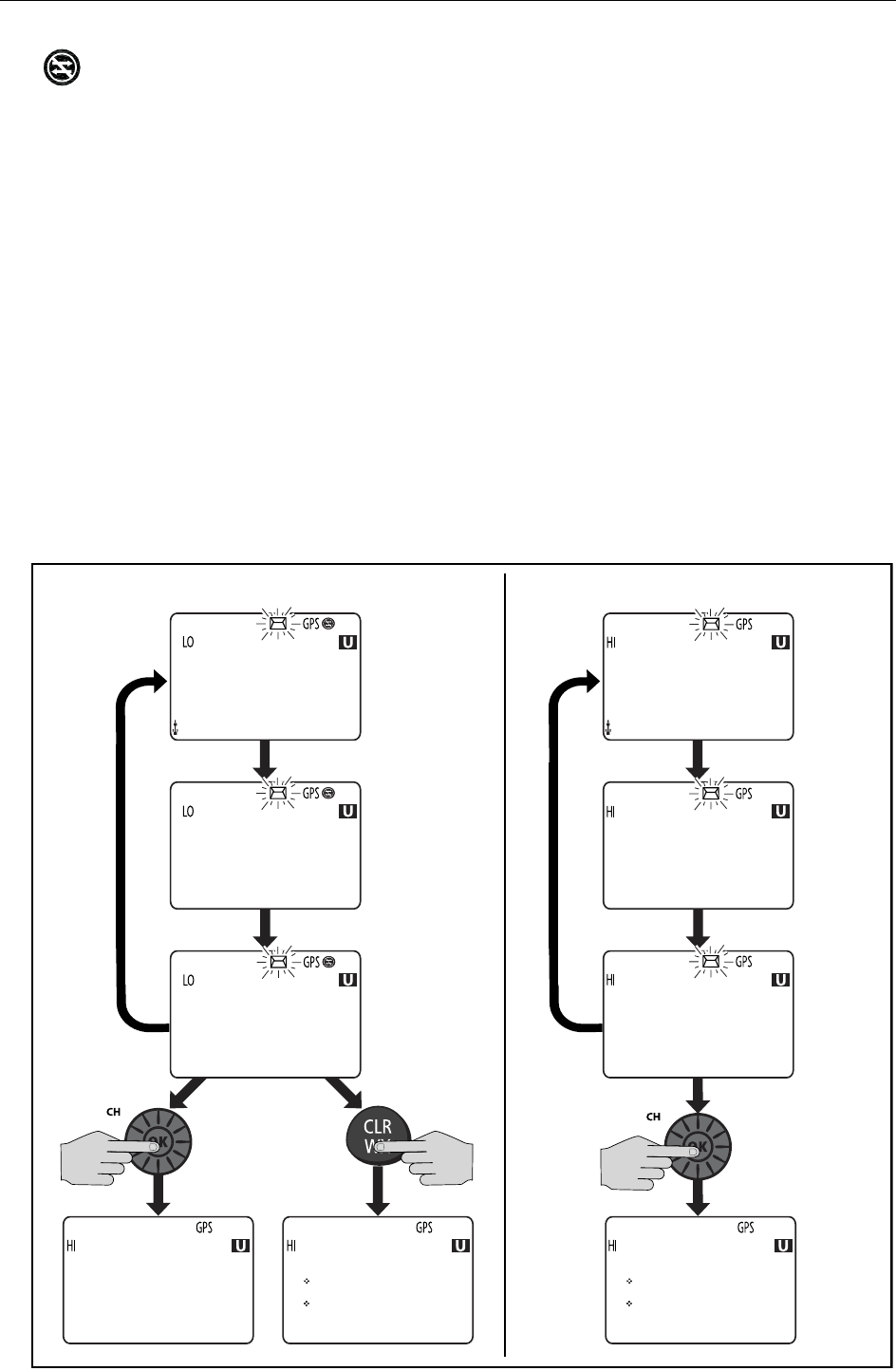
76 Ray49 Marine VHF Radio
To accept an All Ships Urgency or Distress Call when Auto Channel
Change is OFF
1. Press CH/OK. The alert tone is muted, the envelope icon disappears and the
radio switches to channel 16.
2. Press CH/OK again to confirm the channel change. The radio returns to
standby mode. Press PTT to communicate on channel 16.
To accept an All Ships Urgency or Distress Call when Auto Channel
Change is ON
Press the CH/OK knob. The alert tone is muted, the envelope icon disappears and
the radio automatically switches to channel 16. Press PTT to communicate.
If the caller requests that you change to an unsupported working channel the
message INVALID CHANNEL appears on the LCD. If an acknowledgement is sent,
the originating station is sent the message UNABLE TO COMPLY, indicating that
your radio could not make the requested channel change.
...with Auto Channel Change OFF
D10180-1
...with Auto Channel Change ON
68
ALL SHIPS
URGENCY
FROM:
366123456
68
ALL SHIPS
URGENCY
CH CHANGE
REQ TO CH16
68
ALL SHIPS
URGENCY
PRESS [OK] OR
PRESS [CLR]
16
DISTRESS
CH HAS BEEN
CHANGED
PRESS [OK]
68
SHIP/SHIP
27 12.1297N
079 24.4544W
PM12:44LOC
16
ALL SHIPS
URGENCY
FROM:
366123456
16
ALL SHIPS
URGENCY
CH HAS BEEN
CHANGED
16
ALL SHIPS
URGENCY
PRESS [OK]
16
DISTRESS
27 12.1297N
079 24.4544W
PM12:44LOC
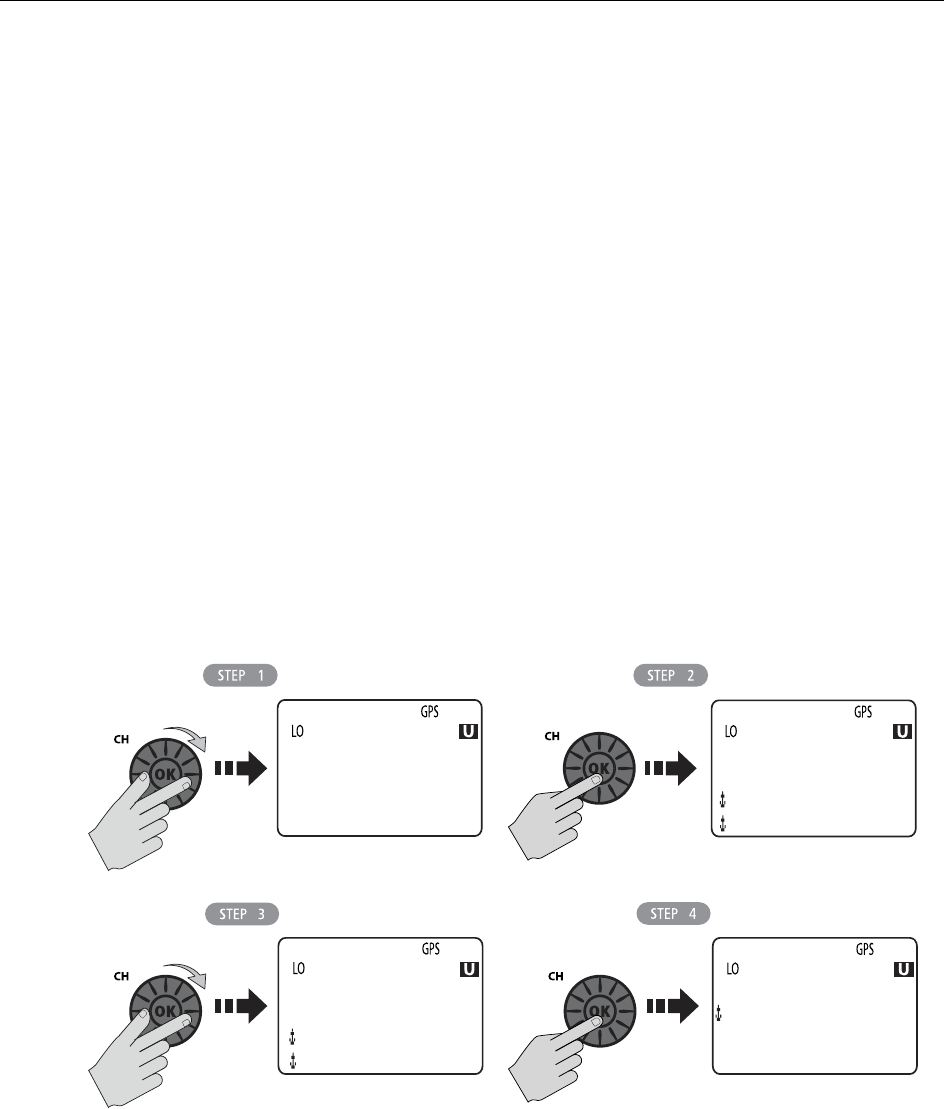
Chapter 5: Digital Selective Calling (DSC) 77
5.7 Position Request
With this option you can request GPS position information from any station
capable of responding to this type of call and for which an MMSI number is
known. You can specify the target station either by selecting it from your MMSI
phonebook or by manually entering its MMSI number.
Specifying the Target Vessel
1. Select POS REQUEST from the DSC menu.
2. Select the target station name from the phonebook.
—or—
Select <MANUAL> and enter the target station’s MMSI number, as described
in “Adding a new Entry“ on page 64.
3. Press SEND to transmit the Position Request Call.
The call is transmitted on channel 70, and then the radio tunes to the original
channel and waits for acknowledgement. During this period you are still able
to receive calls.
When the Position Request is accepted by the receiving station:
When the position request is received, the Ray49 shows that the call has been
accepted by the requested station. The radio sounds a Call Alert tone. Press any
key to mute the alert tone. It shuts off automatically after two minutes.
Press CLR/WX to exit to normal radio operation. You can retrieve the position
information later using DSC MENU > RECV’D CALLS > POSIT’N LOG.
D10182-1
DSC MENU
GROUP
ALL SHIPS
>POS REQUEST
69
POS REQUEST
>[MANUAL]
GULF TIDE
ISLANDER
69
69
POS REQUEST
[MANUAL]
GULF TIDE
> ISLANDER
69
POS REQUEST
ISLANDER
>SEND
CANCEL
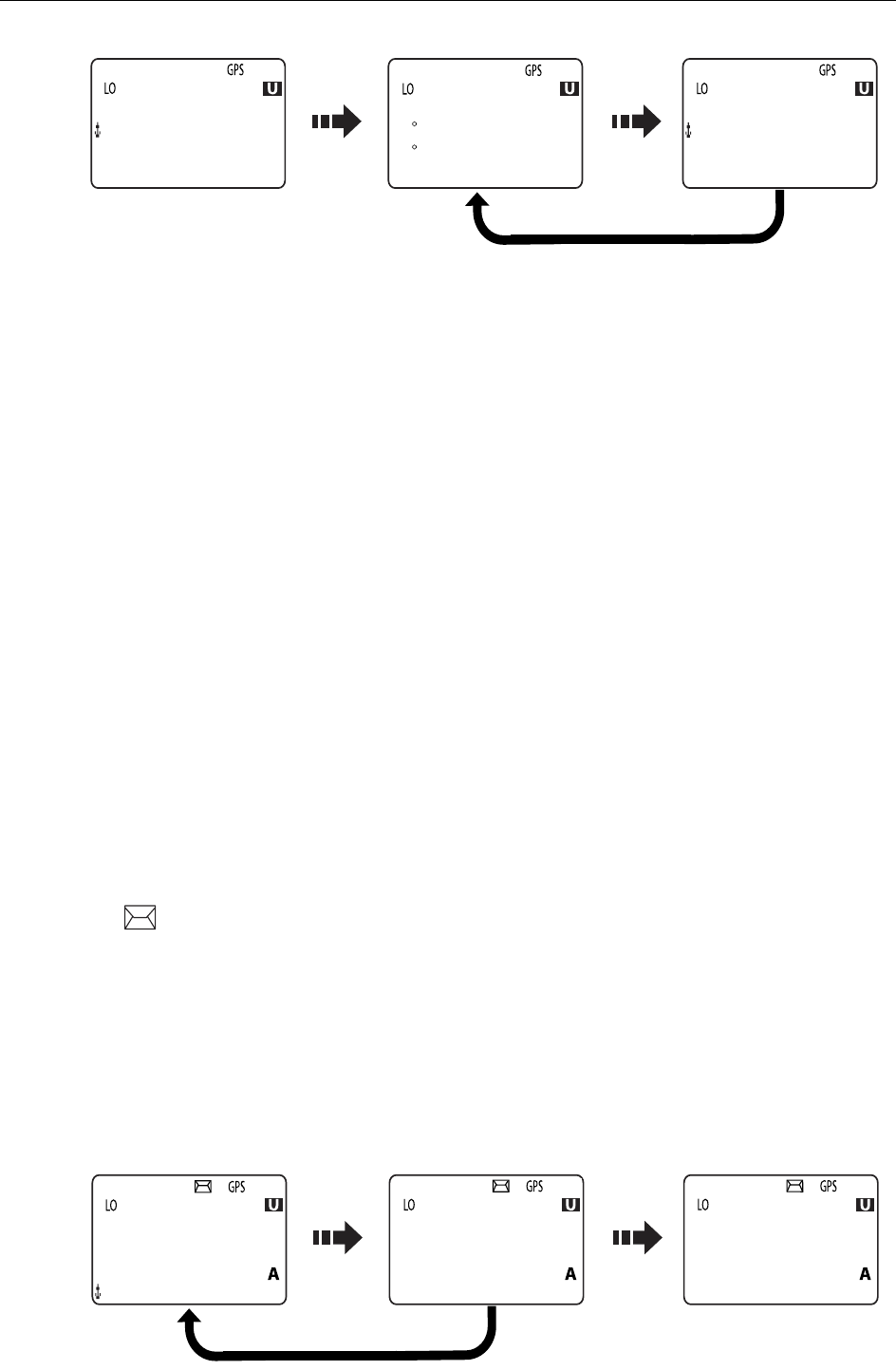
78 Ray49 Marine VHF Radio
Retrieving the Last Received Position Data
1. From the DSC Menu, select RECV’D CALLS.
2. Rotate the CH/OK knob or press the up down arrow keys to select POSIT’N
LOG.
3. Press CH/OK. The last received position request data (LAST CALL) is dis-
played.
Note:
Only the last position is saved. The next received position will overwrite the exist-
ing position data.
Press BACK or the CLR/WX key to exit.
Receiving a Position Request From Another Station
If you receive a position request from another station, how the Ray49 responds
depends on the option you have set in the Position Reply menu item (see page
85). OFF will not send position data under any circumstances. AUTO sends out
your vessel’s position data as soon as it is requested. MANUAL sends out the data
only after you respond to the request.
The 2 alternating pages of data are recorded in the Posit’n Log. The envelope icon
()blinks until automatically accepted or you manually accept the call, reject
the call, or open the resulting unread message stored in the Log. See page
“Received Calls (Logs)“ on page 79.
When a Manual Position Reply is received, the requesting station’s MMSI number
or station name (if entered in the Phonebook) is displayed. Press CH/OK to accept
the request to send your position data. Decline the request by pressing the CLR/
WX key.
REPEATS
D10183-1
POS REQUEST
ISLANDER
AWAITING
POSIT'N
69 69
POS RCV'D
26 04.2172N
080 09.0933W
11:57UTC
POS RCV'D
ISLANDER
PRESS [OK]
69
REPEATS
D10184-1
POSITION
REQUEST
FROM:
SHIP SHAPE
78 78
GPS DATA OK
SEND POSIT'N
PRESS [OK] OR
PRESS [CLR]
POSITION
HAS BEEN
SENT
PRESS [OK]
78

Chapter 5: Digital Selective Calling (DSC) 79
5.8 Received Calls (Logs)
The radio maintains lists of the last received DSC call types by number and time of
call. Separate logs are maintained for the following:
1. Distress (up to 10 entries, per log)
• Distress Log
• Distress ACK Log
• Distress Relay Log
2. Call Log (up to 20 total entries)
• Individual Calls
• All Ship Calls
• Group Calls
3. Position Log
• Last call received
If the calling vessel or station is listed in your DSC Phonebook, the vessel or station
name appears in the display as it is listed. If the caller is not listed in your directory,
the caller’s MMSI ID number appears in the display.
When a DSC Call is received, the envelope icon blinks on the LCD and an asterisk
(*) appears to the left of the appropriate log. The envelope icon and arrow symbol
disappear when the log is opened.
Coast Stations are identified by MMSI ID numbers beginning with”00”. If you
have assigned a name for a Coast Station in the phonebook, a tower symbol ( )
precedes the name field in the log to identify it as such. Similarly, Group Stations
have a single “0” in the initial MMSI number position. If the MMSI ID begins with
any number other than “0”, an anchor symbol ( ) is entered as a prefix to the
name, identifying this as a Ship Station.
Station
Type
MMSI ID
Layout
Phonebook/
Log Symbol
Ship xxxxxxxxx
Group 0xxxxxxxx none
Coast 00xxxxxxx
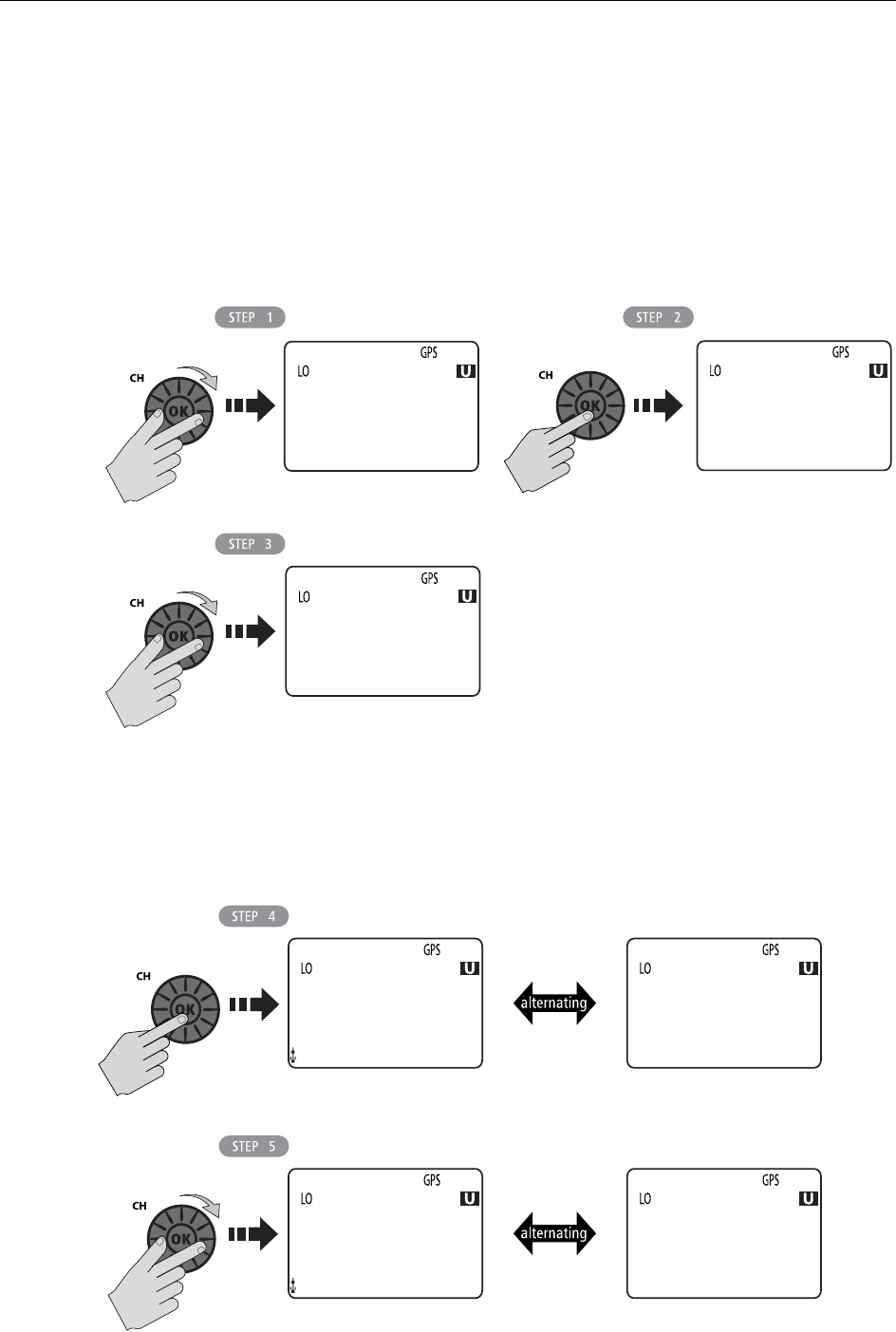
80 Ray49 Marine VHF Radio
To view the Received Call Logs:
1. From the DSC menu, rotate the CH/OK knob until the arrow points to RECV’D
CALL.
2. Press CH/OK. Three log categories appear: DISTRESS, CALL LOG and POSIT’N
LOG. If any of these logs contain an unread item, an asterisk (*) appears to the
left of the log name.
3. Rotate the CH/OK knob until the arrow points to the desired log.
4. Press CH/OK to select. Entry 01 appears first with call type and time of the last
call. This is the most recent call.
5. Using the CH/OK knob on the transceiver or CH up/down arrows on the
microphone, scroll down the list of up to 30 entries.
D10236-1
DSC MENU
ALL SHIPS
POS REQUEST
>RECV'D CALL
72
RECV'D CALL
>DISTRESS
*CALL LOG
POS LOG
72
72
RECV'D CALL
DISTRESS
>*CALL LOG
POS LOG
D10318-1
72
*CALL-01
INDIVIDUAL
ROUTINE
AQUAHOLIC
72
*CALL-01
REQ TO CH 68
PRESS [OK]
FOR OPTIONS
72
*CALL-02
ALL SHIPS
SAFETY
CASTAWAY
72
*CALL-02
REQ TO CH 09
PRESS [OK]
FOR OPTIONS

Chapter 5: Digital Selective Calling (DSC) 81
Log Entry Options
The DSC Call Logs provide additional options for each entry. When the prompt
appears PRESS [OK] FOR MORE OPTIONS, press the CH/OK knob. Select from the
following:
• Call Back. Makes a routine Individual Call to the caller listed in the entry.
• Delete. Remove this entry from the log.
• Save. Stores any undefined MMSI number into the Phonebook and enables
you to assign a corresponding name to it. If a name is already assigned for this
MMSI number in the phonebook, you are prompted to edit the name.
5.9 DSC Setup
The DSC Setup menu item is used to determine the following functions:
• the radio’s MMSI ID number
• how your radio responds to a Position Reply request
• whether your radio automatically changes channels for incoming Distress
and All Ships Urgency Calls
To adjust the DSC settings:
1. Press and hold the MENU/DSC key for 3 seconds to enter DSC Menu mode.
2. Rotate the CH/OK knob until the arrow points to DSC SETUP.
3. Press CH/OK to accept. The DSC Setup screen appears.
Make your selection from the following options:
• MY MMSI ID
• AUTO CH CHG
• POS REPLY
My MMSI ID
This operation stores the MMSI number required for DSC communications,
including Distress Calls. If you try to access a DSC function before entering the
MMSI number, an error message appears and you are prompted to enter the
MMSI ID.
D10319-1
72
OPTIONS
>CALL BACK
DELETE
SAVE

82 Ray49 Marine VHF Radio
Note:
You can obtain an MMSI number from BoatUS (www.boatus.com).
This is a one time operation. After the MMSI number is programmed:
• you will not be able to change it
• only your dealer/distributor can change it
• after entering your MMSI ID, accessing this menu item will merely display the
programmed number
To enter or view the MMSI ID number:
1. From DSC MENU, rotate the CH/OK knob until the arrow points to DSC SETUP.
2. Press the CH/OKknob to accept. The DSC SETUP menu items appear.
3. Press CH/OK to select MY MMSI ID.
If an existing MMSI ID is stored, the value appears. If the MMSI ID is blank,
dashes appear, indicating that one has yet to be entered. The first character
space to be modified is highlighted with a flashing underline.
4. Rotate the CH/OK knob. The flashing underline is replaced with a numeric
character. Continue rotating the knob to scroll through the selections.
5. When the appropriate number appears, press CH/OK to accept.
The next character to be filled in sequence is then underlined.
6. Continue this process until all MMSI characters have been entered.
Note:
If you accidentally select an incorrect digit, press CLR to move the cursor back to
the left.
7. When all digits have been selected, press CH/OK to accept.
8. Press and hold the CH/OK knob.You are prompted to re-enter the MMSI num-
ber.
9. Using the CH/OK knob, re-enter all nine MMSI digits to confirm.
10. Press CH/OK to accept your selections.
If the second entry does not match the first entry, a warning message is dis-
played and you are prompted to retry.
11. When complete, press and hold CH/OK to accept.
12. Press CH/OK one last time to SAVE the MMSI ID number and return to the
DSC SETUP screen.
Note:
• You cannot begin the MMSI ID number with “0” (single zero), as this prefix indicates a
GROUP ID.
• You cannot begin the MMSI ID number with “00” (double zero), as this prefix indicates
a COAST STATION.
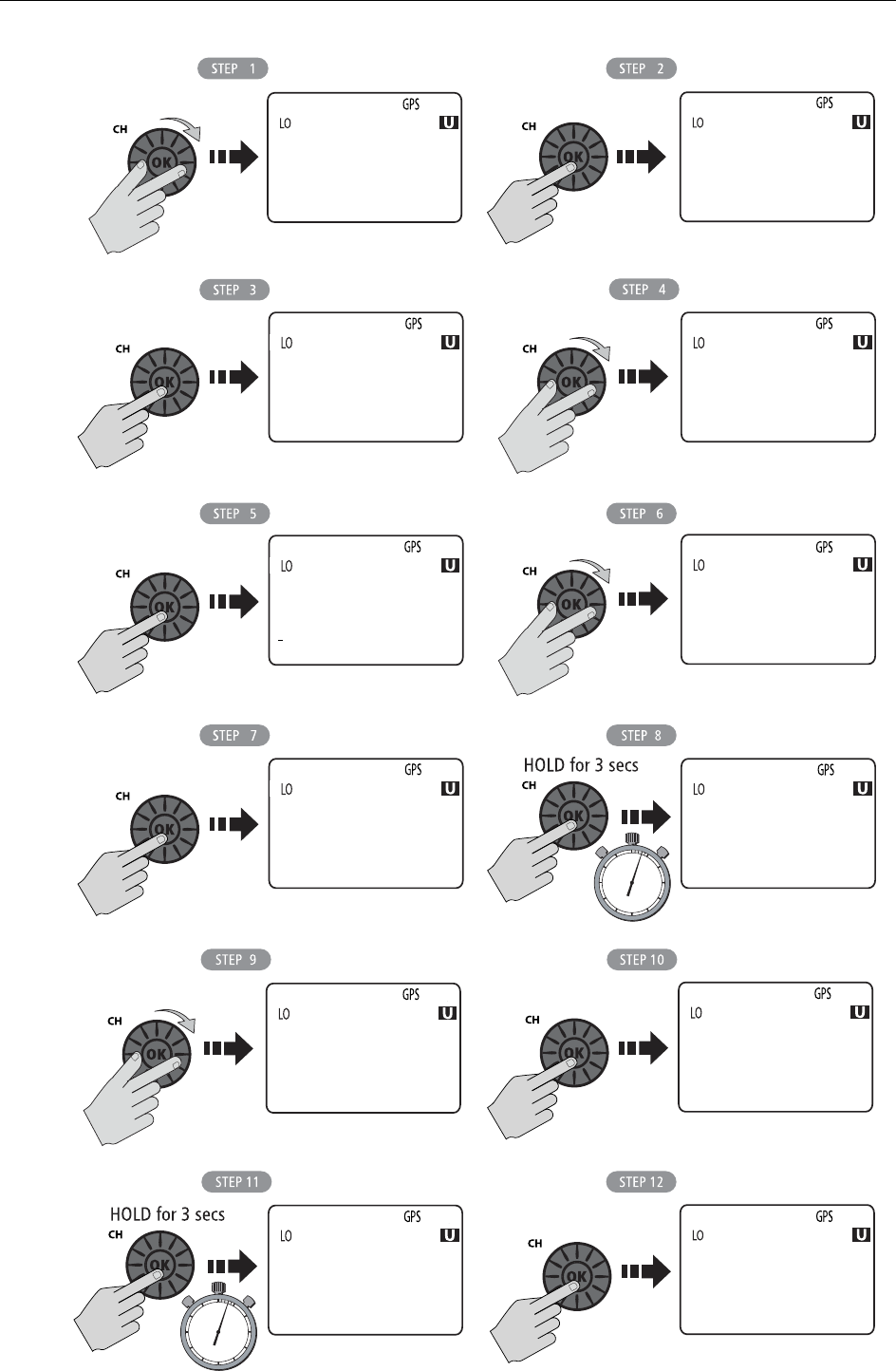
Chapter 5: Digital Selective Calling (DSC) 83
D10237-1
DSC MENU
PHONEBOOK
>DSC SETUP
[BACK]
72
PROGRAMMING
3660123456
>SAVE
CANCEL
72
DSC SETUP
>MY MMSI ID
AUTO CH CHG
POS REPLY
72
72
INPUT
MY MMSI ID:
3660123456
INPUT
MY MMSI ID:
3660123456
HOLD [OK]
72
72
INPUT
MY MMSI ID:
3660123456
HOLD [OK]
72
RE-ENTER
MY MMSI ID:
_--------
72
INPUT
MY MMSI ID:
3 -------
72
INPUT
MY MMSI ID:
3660123456
72
INPUT
MY MMSI ID:
_--------
72
INPUT
MY MMSI ID:
3--------
DSC SETUP
>MY MMSI ID
AUTO CH CHG
POS REPLY
72

84 Ray49 Marine VHF Radio
Automatic Channel Changing for Incoming Calls
For incoming Distress and All Ships Urgency Calls, this option determines whether
your radio automatically switches to Priority Channel 16 to receive the call or
prompts you to manually accept or decline the channel change.
The default setting is to ENABLE the auto channel change. If set OFF, the icon
appears on the LCD.
This feature is useful for preventing your radio from automatically switching
channels while you are maintaining a continuous watch on a certain channel (for
example, in a VTS controlled area) or working with other vessels (for example, for
towage).
Note:
This feature can disable automatic channel switching for incoming DSC Distress
and All Ships Urgency Calls. If enabled, you are responsible for determining whether
manually declining the call is appropriate.
To enable/disable automatic channel change:
1. From DSC SETUP, rotate the CH/OK knob until the arrow points to AUTO CH
CHG.
2. Press the CH/OK knob to accept.
3. Rotate the CH/OK knob until the arrow points to your selection:
• If you accept ON (the default), your Ray49 automatically changes to chan-
nel 16 when a Distress or All Ships Urgency Call is received.
• If you accept OFF, on receipt of a Distress or All Ships Urgency Call you are
presented with brief details of the call and advised that a change to chan-
nel 16 has been requested. You can either accept the channel change or
decline, thereby continuing to monitor your current channel. When set
OFF, the icon appears on the LCD.
If you accept the request, the call is received, a tone sounds and the radio
is changed to channel 16. Pressing any key disables the alarm. If you
ignore the call, after 5 minutes the radio declines the call, records the call
in the Call Log and maintains normal operation.
4. Press CH/OK to accept.
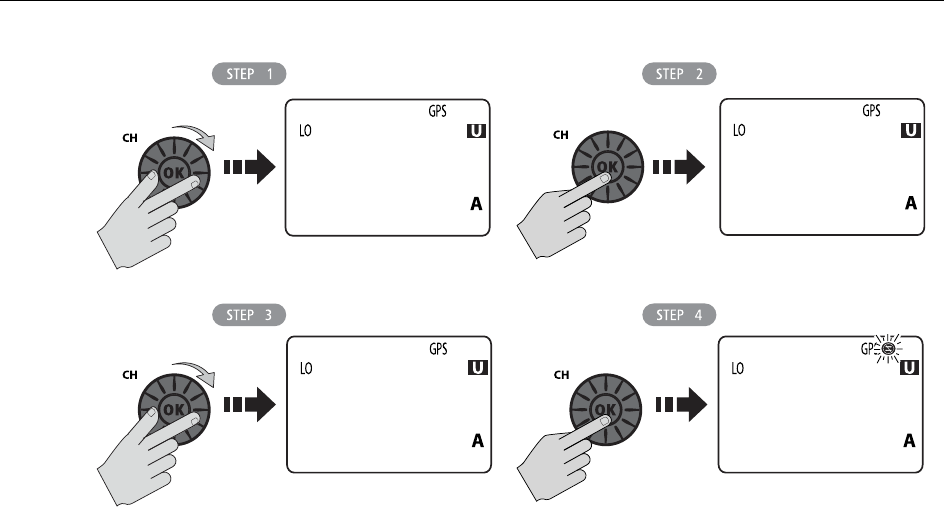
Chapter 5: Digital Selective Calling (DSC) 85
Position Reply
This option enables you to determine how your radio responds to a request for
your GPS position information (lat/lon) from another station.
To enable/disable Position Reply:
1. From DSC SETUP, rotate the CH/OK knob until the arrow points to POS REPLY.
2. Press the CH/OK knob to accept.
3. Rotate the CH/OK knob until the arrow points to your selection:
• AUTO sends out your vessel’s position data as soon as it is requested.
• MANUAL sends out the data only after you respond to the request.
• OFF will not send position data under any circumstances, nor notify you
that the request has been made.
4. Press CH/OK to accept.
The default setting is MANUAL, which is described in “Position Request“ on
page 77.
DSC SETUP
MY MMSI ID
>AUTO CH CHG
POS REPLY
78
AUTO CH CHG
>ON
OFF
78
78
AUTO CH CHG
ON
>OFF
D10326-1
78
DSC SETUP
MY MMSI ID
>AUTO CH CHG
POS REPLY
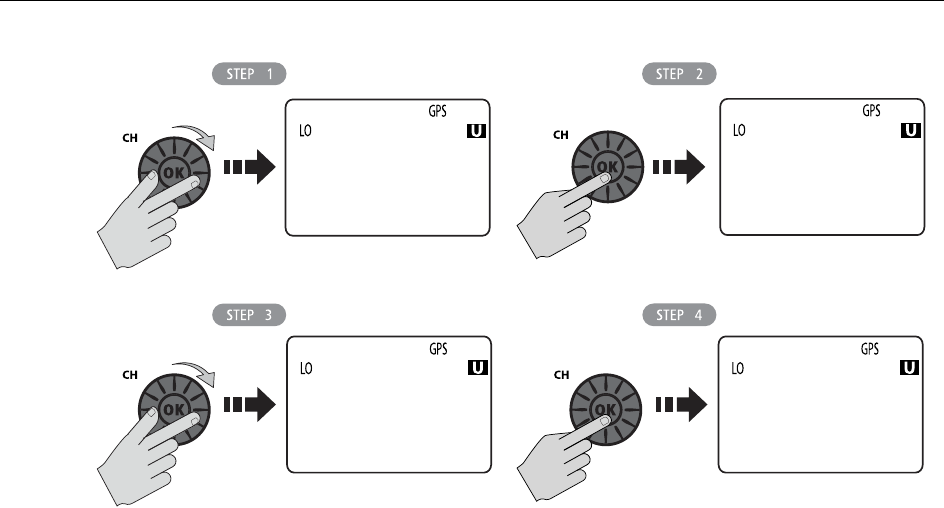
86 Ray49 Marine VHF Radio
POS REPLY
>AUTO
MANUAL
OFF
68
68
POS REPLY
AUTO
>MANUAL
OFF
D10327-1
68
DSC SETUP
MY MMSI ID
AUTO CH CHG
>POS REPLY
DSC SETUP
MY MMSI ID
AUTO CH CHG
>POS REPLY
68

87
Chapter 6: Customer Service
This chapter provides information on service for your Ray49.
6.1 How to Contact Raymarine
On the Internet
Visit the Raymarine World Wide Web site for the latest information on Raymarine
electronic equipment and systems at:
www.raymarine.com
Customer Support
Navigate to the Customer Support page for links for:
• Finding Factory Service locations and Authorized Dealers near you
• Registering your Raymarine products
• Accessing handbooks in Adobe Acrobat format
• Downloading RayTech software updates
• Accessing the Raymarine solution database
Clicking the Find Answers link routes you to our solution database. Search
questions and answers by product, category, keywords, or phrases. If the answer
you are seeking is not available, click the Ask Raymarine tab to submit your own
question to our technical support staff, who will reply to you by e-mail.
Product Repair and Service
In the unlikely event your Raymarine unit should develop a problem, please
contact your authorized Raymarine dealer/distributor for assistance. The dealer is
best equipped to handle your service requirements and can offer timesaving help
in getting the equipment back into normal operation.
In the event that repairs can not be obtained conveniently, product service may
also be obtained by returning the unit to:
Raymarine, Inc.
Product Repair Center
21 Manchester Street
Merrimack, NH 03054-4801

88 Ray49 Marine VHF Radio
The Product Repair Center is open Monday through Friday 8:15 a.m. to 5:00 p.m.
Eastern Time. All products returned to the Repair Center are registered upon
receipt. Should you wish to inquire about the repair status of your unit, contact
the Product Repair Center at:
603-881-5200 ext. 2118
Please have the product reference number, or unit serial number, ready when you
call. We will do everything possible to repair and return your unit quickly.
Accessories and Parts
Many Raymarine accessory items and parts can be obtained directly from your
authorized Raymarine dealer.
However, if you are in need of an item not available from the retailer, please
contact Raymarine Technical Services at:
603-881-5200 ext. 2333
Please have the Raymarine item or part number ready when calling if placing an
order. If you are not sure which item is appropriate for your unit, you should first
contact the Technical Support Department to verify your requirements.
Technical Support
For technical support, call:
603-881-5200 ext. 2444
Our Technical Support Specialists are available to answer questions about
installing, operating and trouble-shooting all Raymarine products. Technical
Service is available Monday through Friday 8:00 AM to 6:00 PM Eastern Time.
Questions can be sent directly to our Technical Support Department via the
Internet. Point your browser to www.raymarine.com and click on the Customer
Support link. From there, select Find Answers and click the Ask Raymarine tab.

89
Appendix A: Specifications
General
Mounting Bracket or flush mount
Size (H x W x D): Ray49
Flush Mounted
Bracket Mounted
2.87 x 6.57 x 6.89in (73 x 167 x 175mm)
3.56 x 7.05 x 6.89in (90.3 x 179 x 175mm)
Weight, Ray49:
Transceiver & Microphone 2.5 lbs (1.13 kg)
Power 12 VDC system (13.6 VDC, typical)
Environmental:
Operating Range
Storage Range
Humidity
Waterproof to IPX7
–10°C to +50°C
–20°C to +70°C
up to 95%
Frequency Range:
Transmit:
Receive
156.050 to 157.425 MHz
156.050 to 163.275 MHz
Oscillate Mode PLL
Modulation FM (16K0G3E)
DSC (16K0G2B)
Channel Spacing 25 kHz Increments
Frequency Stability +/- 10 PPM (+/- 0.001%)
Audio Output Power 3.5 watts, typical (at 10% distortion with 4 ohm load),
5 watts peak.
Antenna Port Impedance 50 ohms, typical
NMEA Port Impedance 100 ohms
External Speaker Impedance 4 ohms
NMEA IN Sentences sup-
ported (NMEA 0183 ver.
3.01):
GLL Geographic position, Latitude/Longitude
GGA GPS fix data
RMA Recommended minimum data for LORAN
RMC Recommended minimum data for GPS
GNS GNSS fix data
NMEA OUT Sentences
(NMEA 0183 ver. 3.01):
DSC DSC data
DSE Extended DSC data

90 Ray49 Marine VHF Radio
Transmitter
Receiver
Frequency Error 10 ppm
RF Power (at 13.6 VDC):
Hi Mode
Lo Mode
25 W
1 W
Maximum Deviation ± 5 KHz
FM Hum and Noise Level less than -40 dB below audio level
Audio Distortion less than 10%
Adjacent Channel Power more than 70 dB
Spurious/Harmonic Emissions less than -70 dBc
Current Drain:
Hi Power at 13.6V DC less than 6 A
Sensitivity @ 12db SINAD 0.28 µV, typical
Hum and Noise less than -40 dB below audio level
Audio Distortion less than 10%
Adjacent Channel Rejection more than 70 dB, typical
Intermodulation Rejection Ratio more than 68 dB, typical
Spurious Image Rejection more than 70 dB, typical
Squelch Sensitivity @ 12db SINAD
at tight
at threshold
less than 1µV,
less than 0.28 µV
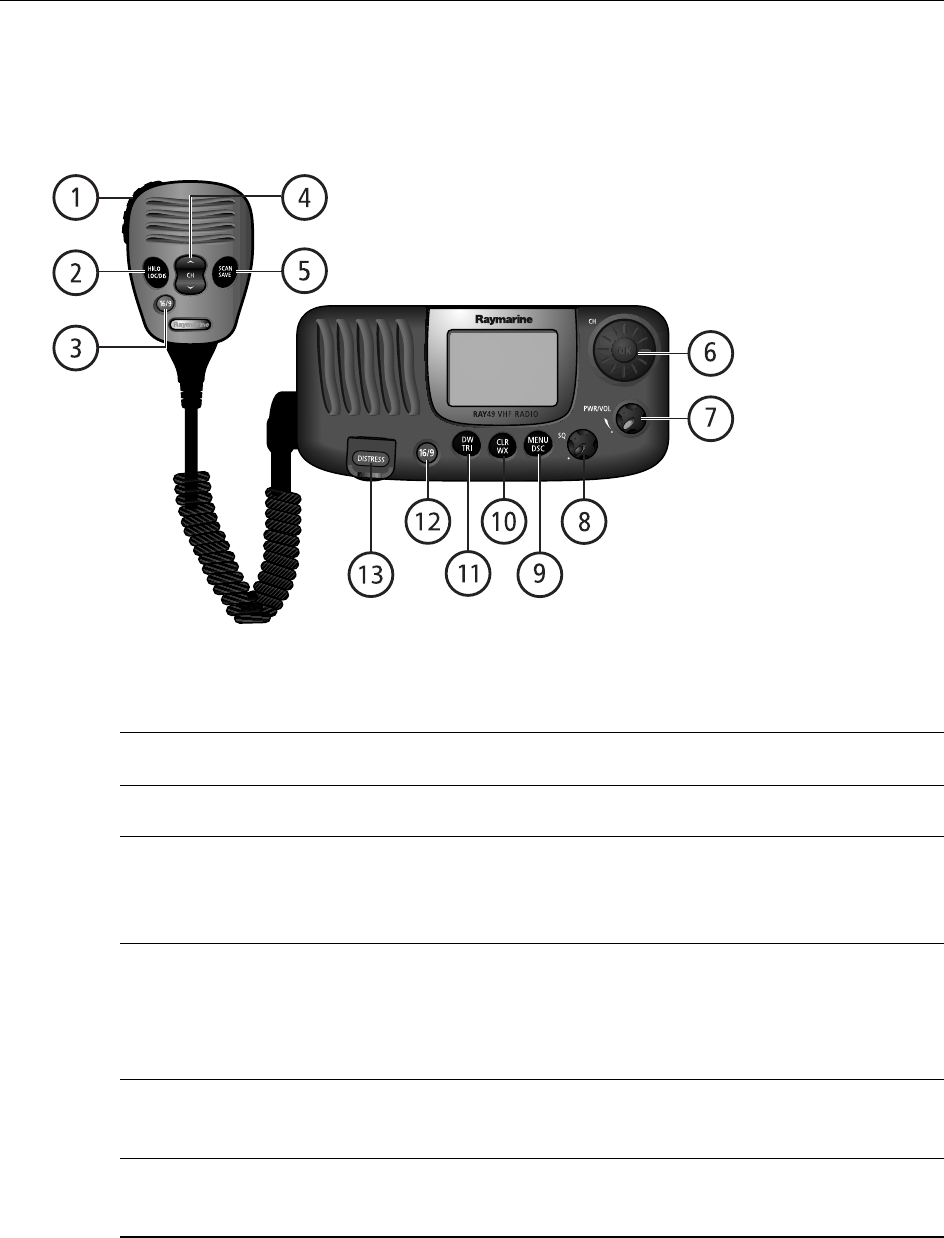
91
Appendix B: Radio Controls
This section is a quick reference to your radio’s controls.
Microphone Keys
Key Name Press & Release Press & Hold 3 seconds
1. PTT Push-to-Talk Push-to-Talk
2. HI/LO
LOC/DIS
TX Power High/Low and ACCEPT
key for menu item selections
Toggles between full receiver sensi-
tivity (Distant mode) and attenuated
receiver sensitivity (Local mode).
3. 16/9 Switch between the Priority and
Working Channels
Switch to Secondary Priority CH (9);
If already tuned to secondary chan-
nel, program a new secondary Prior-
ity Channel.
4. UP/DOWN Channel changing and navigating
menu item selections
Rapid channel change and navigat-
ing menu item selections
5. SCAN/
SAVE
Initiate Priority Saved Scan mode
or terminate any active scan.
SAVE/DELETE channel to/from
memory
D10114-1
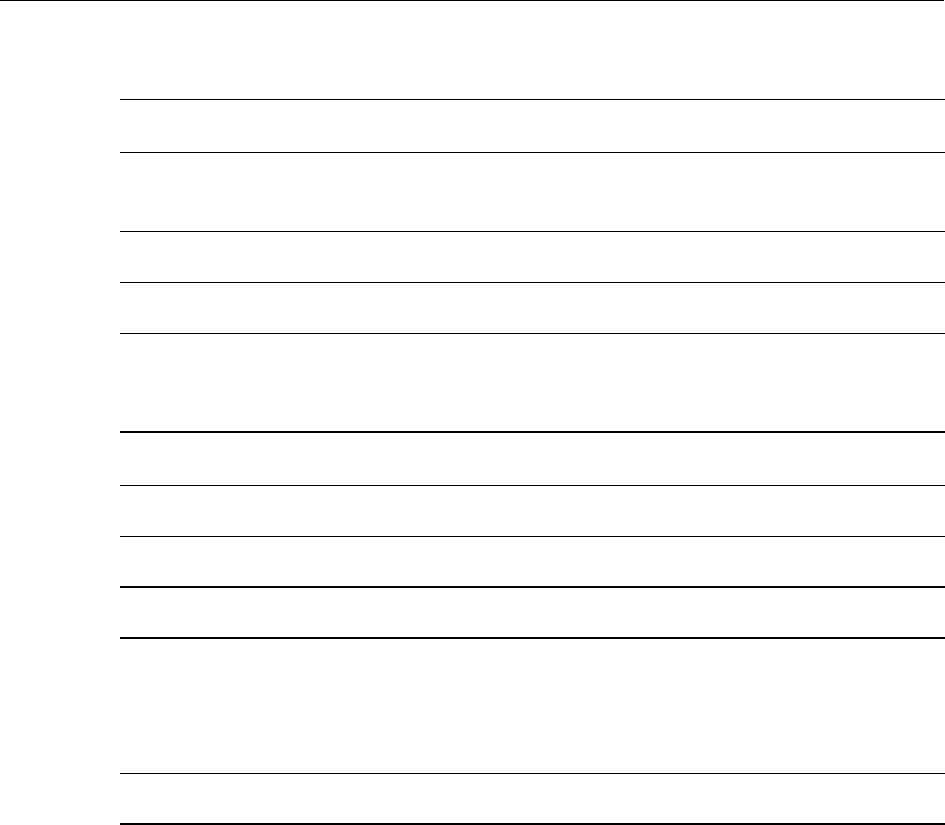
92 Ray49 Marine VHF Radio
Transceiver Controls
Transceiver Push Keys
Key Name Function
6. CH/OK Rotate to change channels or navigate menu items.
Press to accept menu item selections.
7. PWR/VOL Power radio ON / OFF and adjust volume level
8. SQ Adjust squelch threshold level
Key Name Press & Release Press & Hold 3 seconds
9. MENU/DSC Activate Menu functions Activate DSC functions
10. CLR/WX Cancel function Weather Channel Mode
11. DW/TRI Activate Dual Watch Activate Tri Watch
12. 16/9 Switch between the Priority
and Working Channels
Switch to secondary Priority CH (9);
If already tuned to secondary chan-
nel, program a new secondary Prior-
ity Channel.
13. DISTRESS Designate Distress Type Make Distress Call
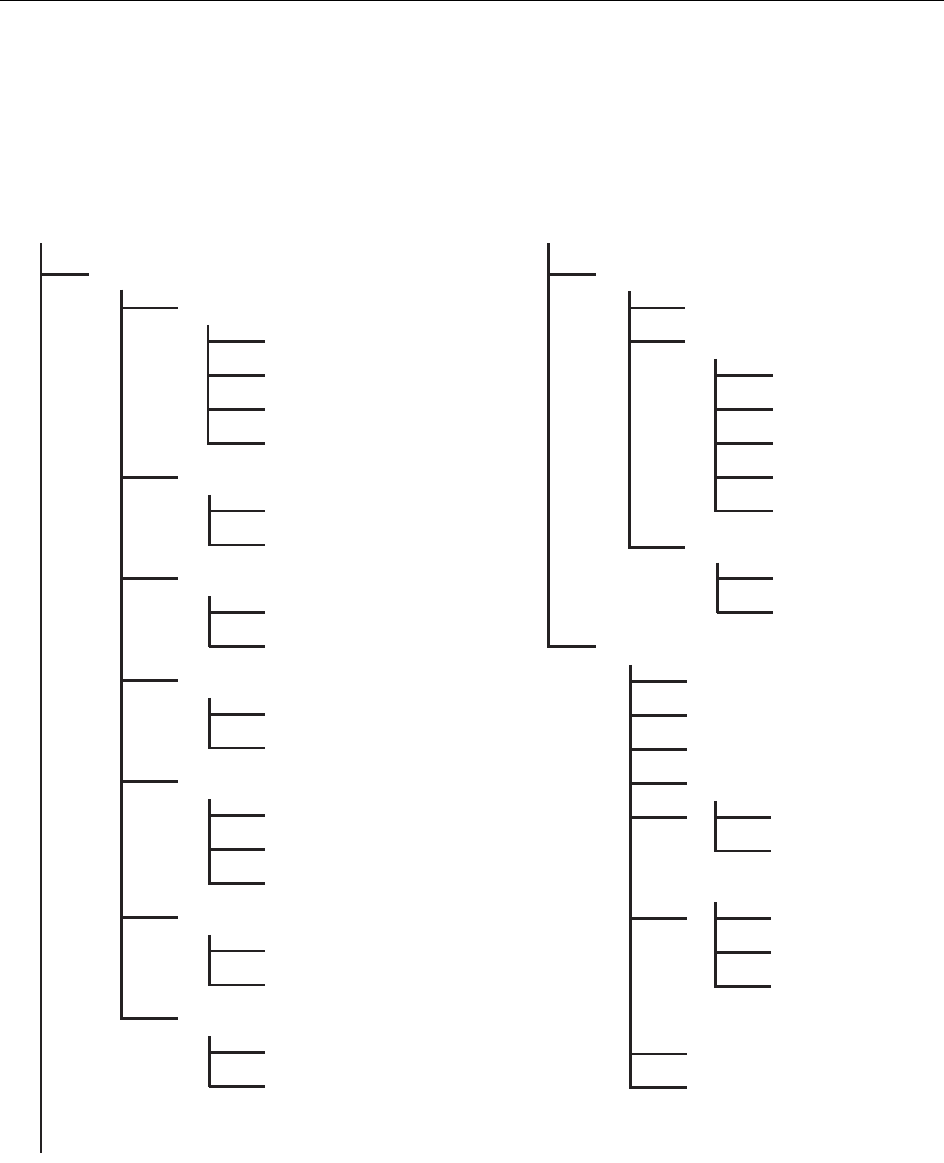
93
Appendix C: Menu Structure
Following is the structure of the menu that appears when the MENU/DSC key is pressed
and then immediately released.
VHF OPERATIONS
Scan Mode
MENU
D10159-1
All Scan
Priority All Scan
Saved Scan
Priority Saved Scan
Lat/Lon
Time Display
Time Offset
Time Format
COG/SOG
HI/LO Power
High (25W)
Low (1 W)
Save Channel
Save
Clear
On
Off
Watch Mode
Dual Watch
Tri Watch
Channel Name
Edit
Clear
Sensitivity
Local
(continued in next column)
Distant
Frequency Band
USA
International
Canada
MENU
GPS SETUP
Manual Position
Setting
NMEA Output
(continued)
True
Magnetic
SYSTEM CONFIG
Backlight
Contrast
Key Beep
Bearing Mode
Knots
MPH
KPH
Speed Unit
System Test
Version Number
Reset

94 Ray49 Marine VHF Radio
Following is the structure of the menu that appears when the MENU/DSC key is
pressed and held for 3 seconds.
--------- PHONEBOOK
---------- New entry
---------- List of phonebook entries
DSC
--------- INDIVIDUAL
---------- Manual call
---------- List of phonebook entries
--------- GROUP
---------- Call
---------- My Group ID
--------- ALL SHIPS
---------- Urgency
---------- Safety
--------- POSITION REQUEST
---------- Manual call
---------- List of phonebook entries
--------- RECV'D CALLS
---------- Distress
---------- Call Log
---------- Posit'n Log
--------- DSC SETUP
---------- My MMSI ID
----------
Position Reply
----------
Automatic channel change
D9311-3
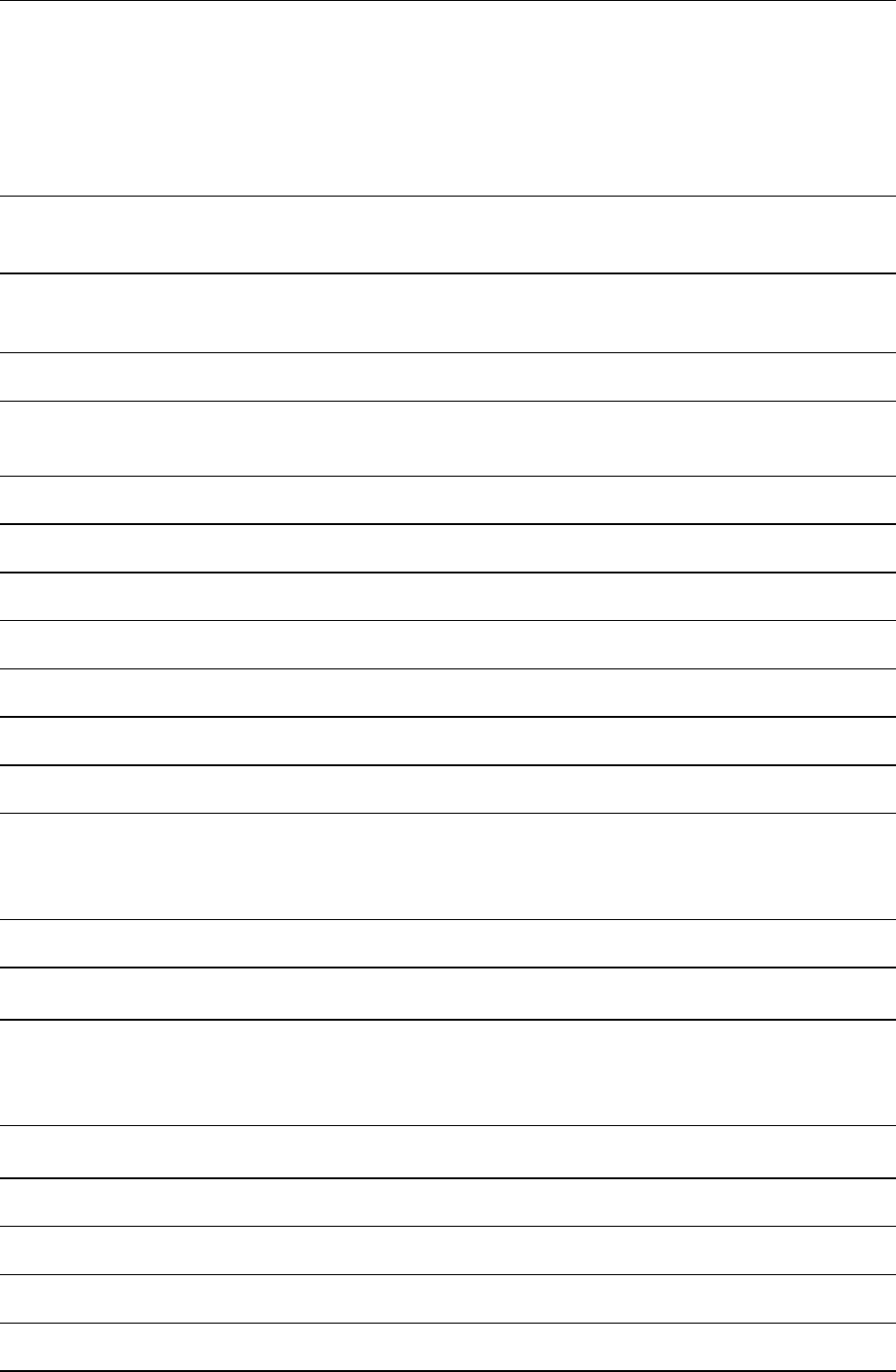
95
Appendix D: Channel List
U.S. Marine VHF Channels and Frequencies
CH.
No
XMIT
Freq
RCV
Freq
Single
Freq Use
01A 156.050 156.050 x Port Operations and Commercial, VTS.
Available only in New Orleans / Lower Mississippi area. 1
03A 156.150 156.150 x U.S. Government only
05A 156.250 156.250 x Port Operations or VTS in the Houston, New Orleans and Seattle
areas.
06 156.300 156.300 x Intership Safety
07A 156.350 156.350 x Commercial
08 156.400 156.400 x Commercial (Intership only)
09 156.450 156.450 x Boater Calling. Commercial and Non-Commercial.
10 156.500 156.500 x Commercial
11 156.550 156.550 x Commercial. VTS in selected areas.
12 156.600 156.600 x Port Operations. VTS in selected areas.
13 156.650 156.650 x Intership Navigation Safety (Bridge-to-bridge). Ships
>20meters in length maintain a listening watch on this channel
in US waters. 2, 6
14 156.700 156.700 x Port Operations. VTS in selected areas.
15 – 156.750 x Environmental (Receive only). Used by Class ‘C’ EPIRBs. 3
16 156.800 156.800 x International Distress, Safety and Calling. Ships required to
carry radio, USCG, and most coast stations maintain a listening
watch on this channel. 4
17 156.850 156.850 x State Control 5
18A 156.900 156.900 x Commercial
19A 156.950 156.950 x Commercial
20 157.000 161.600 Port Operations (duplex)
20A 157.000 157.000 x Port Operations
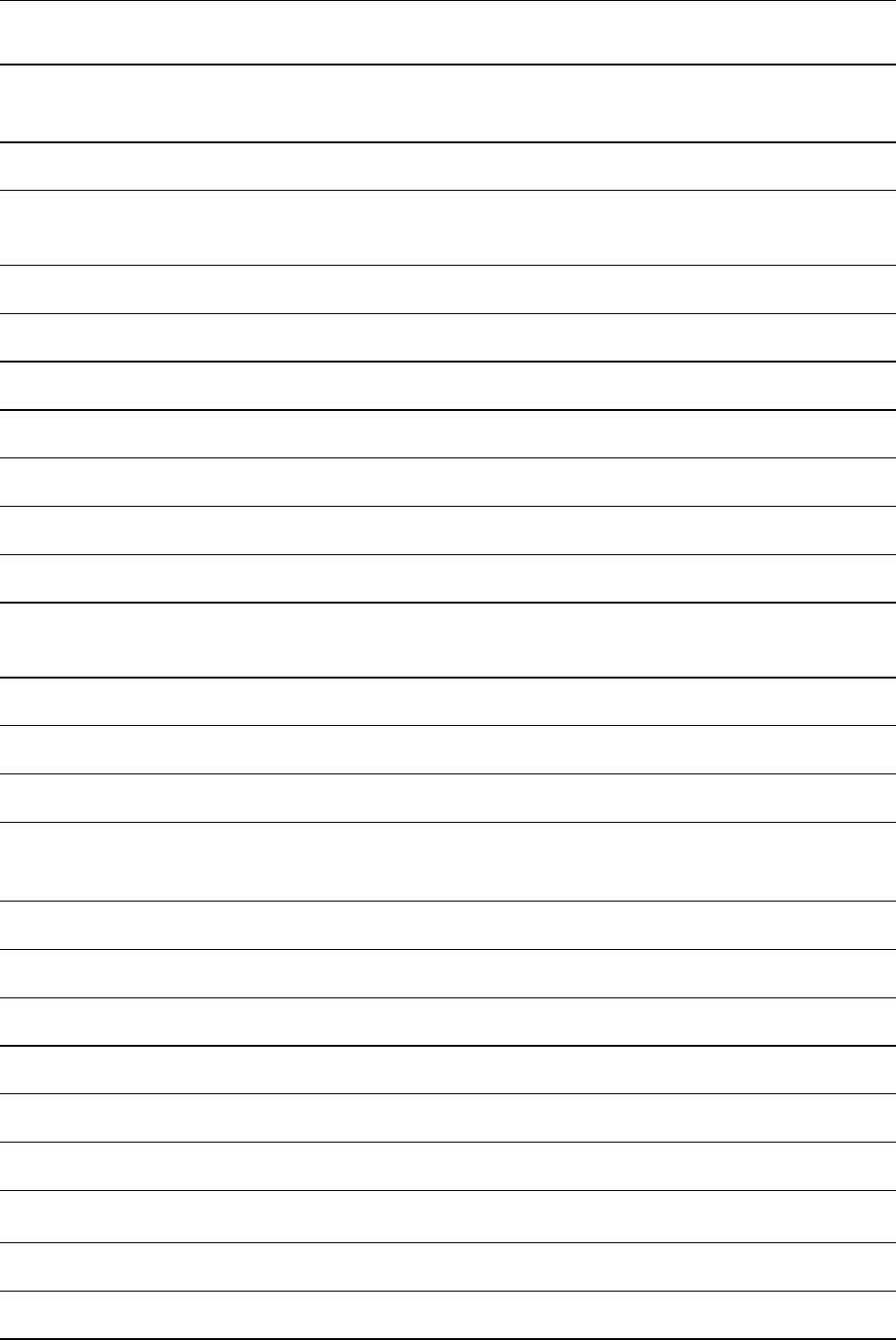
96 Ray49 Marine VHF Radio
21A 157.050 157.050 x U.S. Coast Guard only
22A 157.100 157.100 x Coast Guard Liaison and Maritime Safety Information Broad-
casts. Broadcasts announced on channel 16.
23A 157.150 157.150 x U.S. Coast Guard only
24 157.200 161.800 Public Correspondence (Marine Operator)
25 157.250 161.850 Public Correspondence (Marine Operator)
26 157.300 161.900 Public Correspondence (Marine Operator)
27 157.350 161.950 Public Correspondence (Marine Operator)
28 157.400 162.000 Public Correspondence (Marine Operator)
61A 156.075 156.075 x U.S. Government only
63A 156.175 156.175 x Port Operations and Commercial, VTS. Available only in New
Orleans / Lower Mississippi area.
64A 156.225 156.225 x U.S. Coast Guard only
65A 156.275 156.275 x Port Operations
66A 156.325 156.325 x Port Operations
67 156.375 156.375 x Commercial. Used for Bridge-to-bridge communications in
lower Mississippi River. Intership only. 6
68 156.425 156.425 x Non-Commercial
69 156.475 156.475 x Non-Commercial
71 156.575 156.575 x Non-Commercial
72 156.625 156.625 x Non-Commercial (Intership only)
73 156.675 156.675 x Port Operations
74 156.725 156.725 x Port Operations
77 156.875 156.875 x Port Operations (Intership only) 5
78A 156.925 156.925 x Non-Commercial
79A 156.975 156.975 x Commercial. Non-Commercial in Great Lakes only.
CH.
No
XMIT
Freq
RCV
Freq
Single
Freq Use
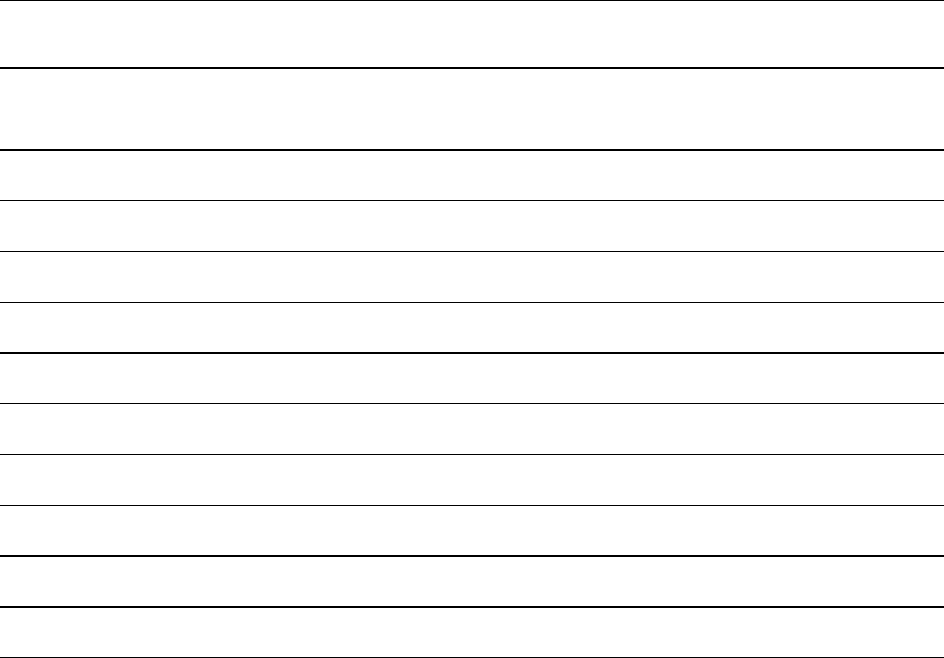
Appendix D: Channel List 97
• Recreational boaters normally use channels listed as Non-Commercial: 68, 69, 71, 72,
78A.
• Channel 70 is used exclusively for Digital Selective Calling (DSC) and is not available for
regular voice communications.
• Channels 75 and 76 are reserved as guard bands for Channel 16 and are not available for
regular voice communications.
Notes:
1. The letter “A” following a channel number indicates simplex use of the ship station trans-
mit side of an international semi-duplex channel. Operations are different from that of
international operations on that channel.
2. Channel 13 should be used to contact a ship when there is danger of collision. All ships of
length 20 meters or greater are required to guard VHF channel 13, in addition to VHF
channel 16, when operating within U.S. territorial waters.
3. Channel is Receive Only.
4. Channel 16 is used for calling other stations or for distress alerting.
5. Output power is fixed at 1 watt only.
6. Output power is initially set to 1 watt. User can temporarily override this restriction to
transmit at high power.
80A 157.025 157.025 x Commercial. Non-Commercial in Great Lakes only
81A 157.075 157.075 x U.S. Government only – Environmental protection operations.
82A 157.125 157.125 x U.S. Government only
83A 157.175 157.175 x U.S. Coast Guard only
84 157.225 161.825 Public Correspondence (Marine Operator)
85 157.275 161.875 Public Correspondence (Marine Operator)
86 157.325 161.925 Public Correspondence (Marine Operator)
87 157.375 161.975 Public Correspondence Marine Operator)
88 157.425 162.025 Public Correspondence only near Canadian border
88A 157.425 157.425 x Commercial, Intership only
CH.
No
XMIT
Freq
RCV
Freq
Single
Freq Use
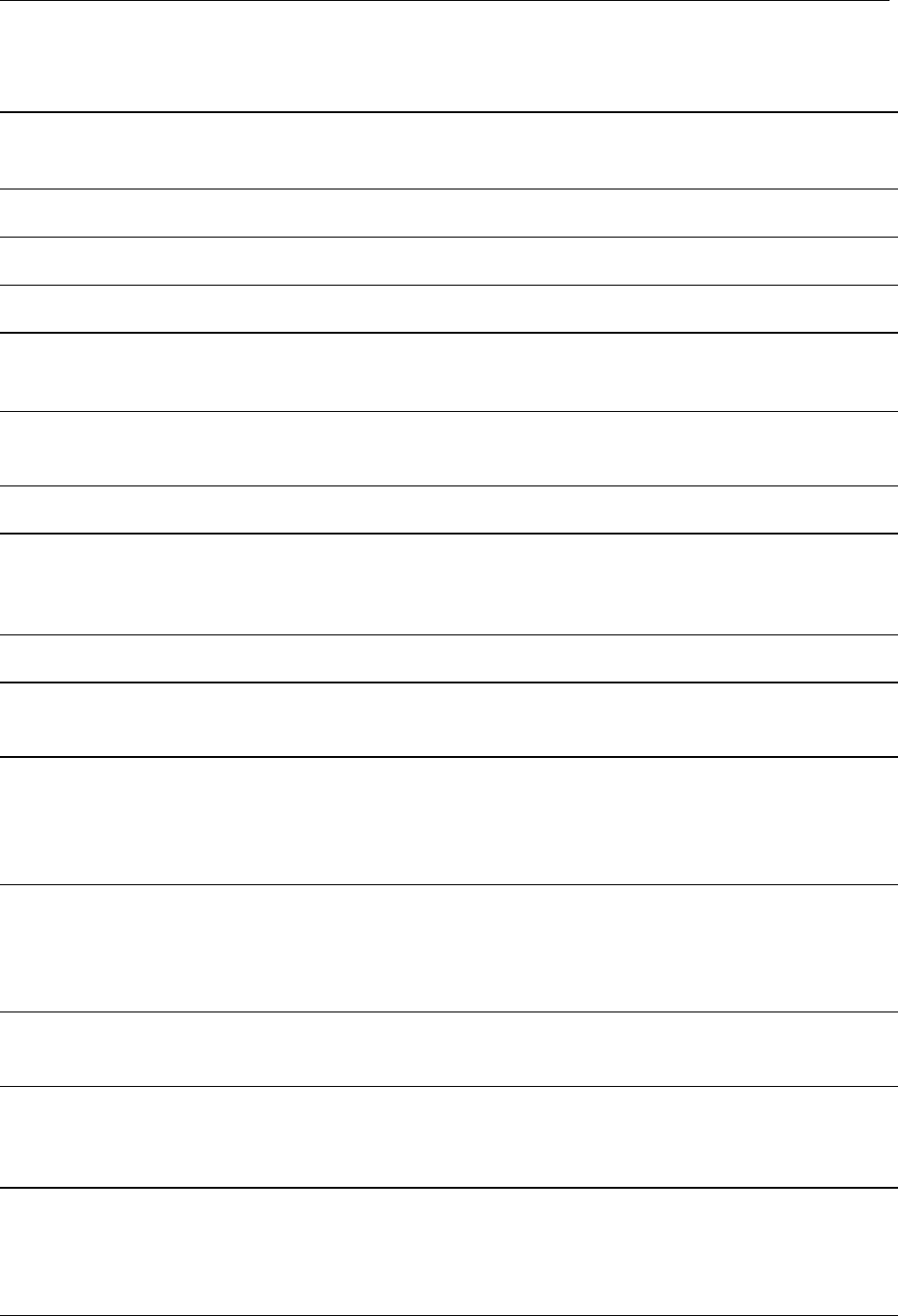
98 Ray49 Marine VHF Radio
Canadian Marine VHF Channels and Frequencies
CH
No.
XMIT
Freq
RCV
Freq
Area of
Operation Use
01 156.050 160.650 PC Public Correspondence
02 156.100 160.700 PC Public Correspondence
03 156.150 160.750 PC Public Correspondence
04A 156.200 156.200 PC Intership, Ship/Shore and Safety:
Canadian Coast Guard search and rescue1
04A 156.200 156.200 EC Intership, Ship/Shore and Commercial:
Commercial fishing only
05A 156.250 156.250 Ship Movement
06 156.300 156.300 All areas Intership, Commercial, Non-commercial and Safety:
May be used for search and rescue communications
between ships and aircraft.
07A 156.350 156.350 All areas Intership, Ship/Shore, Commercial
08 156.400 156.400 WC, EC Intership, Commercial and Safety:
Also assigned for operations in the Lake Winnipeg area.
09 156.450 156.450 AC Intership, Ship/Shore, Commercial, Non-commercial and
Ship Movement: May be used to communicate with aircraft
and helicopters in predominantly maritime support opera-
tions.
10 156.500 156.500 AC, GL Intership, Ship/Shore, Commercial, Non-commercial,
Safety and Ship Movement: May also be used for communi-
cations with aircraft engaged in coordinated search and
rescue and antipollution operations.
11 156.550 156.550 PC, AC, GL Intership, Ship/Shore, Commercial, Non-commercial and
Ship Movement: Also used for pilotage purposes.
12 156.600 156.600 WC, AC, GL Intership, Ship/Shore, Commercial, Non-commercial and
Ship Movement: Port operations and pilot information and
messages.
13 156.650 156.650 All areas Intership, Commercial, Non-commercial and Ship Move-
ment:
Exclusively for bridge-to-bridge navigational traffic. Lim-
ited to 1-watt maximum power.
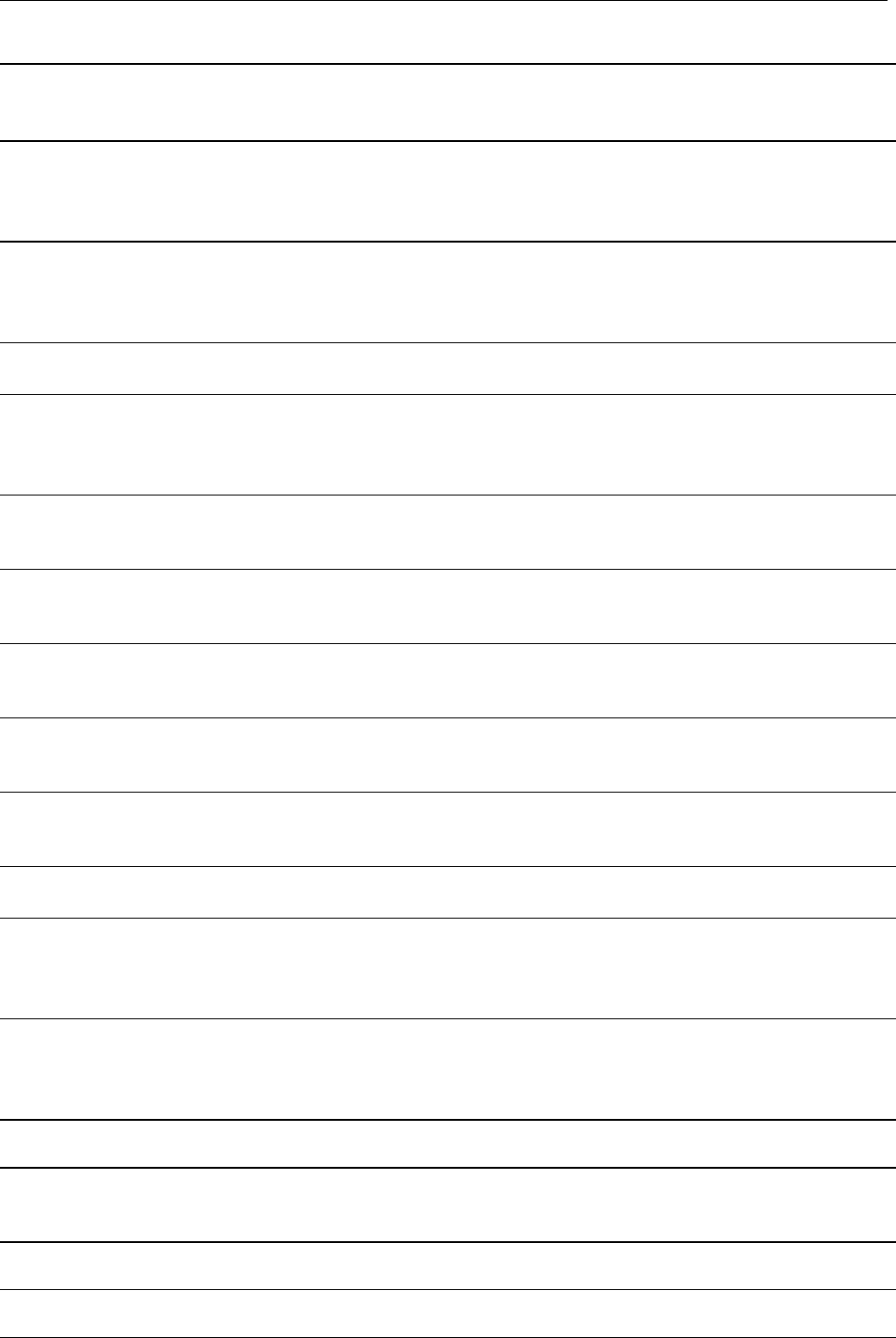
Appendix D: Channel List 99
14 156.700 156.700 AC, GL Intership, Ship/Shore, Commercial, Non-commercial and
Ship Movement: Port operations and pilot information and
messages.
15 156.750 156.750 All areas Intership, Ship/Shore, Commercial, Non-commercial and
Ship Movement: All operations limited to 1-watt maximum
power. May also be used for on-board communications.
16 156.800 156.800 All areas International Distress, Safety and Calling2
17 156.850 156.850 All areas Intership, Ship/Shore, Commercial, Non-commercial and
Ship Movement: All operations limited to 1-watt maximum
power. May also be used for on-board communications.
18A 156.900 156.900 All areas Intership, Ship/Shore and Commercial:
Towing on the Pacific Coast.
19A 156.950 156.950 All areas
except PC
Intership and Ship/Shore:
Canadian Coast Guard only.
19A 156.950 156.950 PC Intership and Ship/Shore:
Various Government departments.
20 157.000 161.600 All areas Ship/Shore, Safety and Ship Movement:
Port operations only with 1-watt maximum power.
21A 157.050 157.050 All areas Intership and Ship/Shore:
Canadian Coast Guard only.
21B - 161.650 All areas Safety: Continuous Marine Broadcast (CMB) service.3
22A 157.100 157.100 All areas Intership, Ship/Shore, Commercial and Non-commercial:
For communications between Canadian Coast Guard and
non-Canadian Coast Guard stations only.
23 157.150 161.750 PC Ship/Shore and Public Correspondence:
Also in the inland waters of British Columbia and the
Yukon.
24 157.200 161.800 All areas Ship/Shore and Public Correspondence
25 157.250 161.850 PC Ship/Shore and Public Correspondence: Also assigned for
operations in the Lake Winnipeg area.
25B - 161.850 AC Safety: Continuous Marine Broadcast (CMB) service.
26 157.300 161.900 All areas Ship/Shore, Safety and Public Correspondence
CH
No.
XMIT
Freq
RCV
Freq
Area of
Operation Use
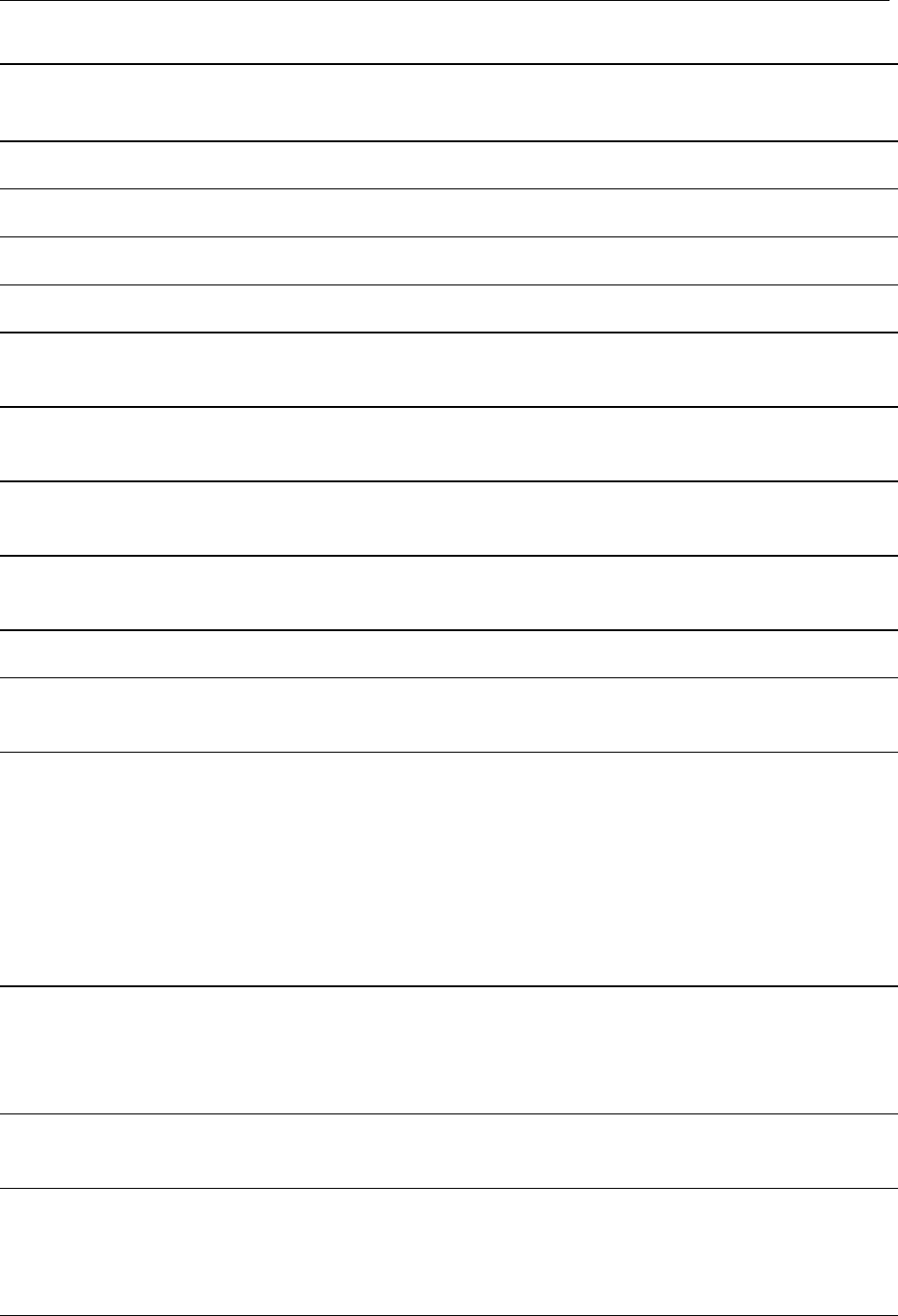
100 Ray49 Marine VHF Radio
27 157.350 161.950 AC, GL, PC Ship/Shore and Public Correspondence
28 157.400 162.000 PC Ship/Shore, Safety and Public Correspondence
28B - 162.000 AC Safety: Continuous Marine Broadcast (CMB) service.
60 156.025 160.625 PC Ship/Shore and Public Correspondence
61A 156.075 156.075 PC Intership and Ship/Shore:
Canadian Coast Guard only.
61A 156.075 156.075 EC Intership, Ship/Shore and Commercial:
Commercial fishing only.
62A 156.125 156.125 PC Intership and Ship/Shore:
Canadian Coast Guard only.
62A 156.125 156.125 EC Intership, Ship/Shore and Commercial:
Commercial fishing only.
64 156.225 160.825 PC Ship/Shore and Public Correspondence
64A 156.225 156.225 EC Intership, Ship/Shore and Commercial:
Commercial fishing only.
65A 156.275 156.275 Intership, Ship/Shore, Commercial, Non-commercial,
Safety:
Search & rescue and antipollution operations on the Great
Lakes. Towing on the Pacific Coast. Port operations only in
the St. Lawrence River areas with 1W maximum power.
Pleasure craft in the inland waters of Alberta,
Saskatchewan and Manitoba (excluding Lake Winnipeg
and the Red River).
66A 156.325 156.325 Intership, Ship/Shore, Commercial, Non-commercial,
Safety and Ship Movement: Port operations only in the
St.Lawrence River/Great Lakes Areas with 1-watt maxi-
mum power.
67 156.375 156.375 EC Intership, Ship/Shore and Commercial:
Commercial fishing only.
67 156.375 156.375 All areas
except EC
Intership, Ship/Shore, Commercial, Non-commercial,
Safety: May also be used for communications with aircraft
engaged in coordinated search and rescue and antipollu-
tion operations.
CH
No.
XMIT
Freq
RCV
Freq
Area of
Operation Use
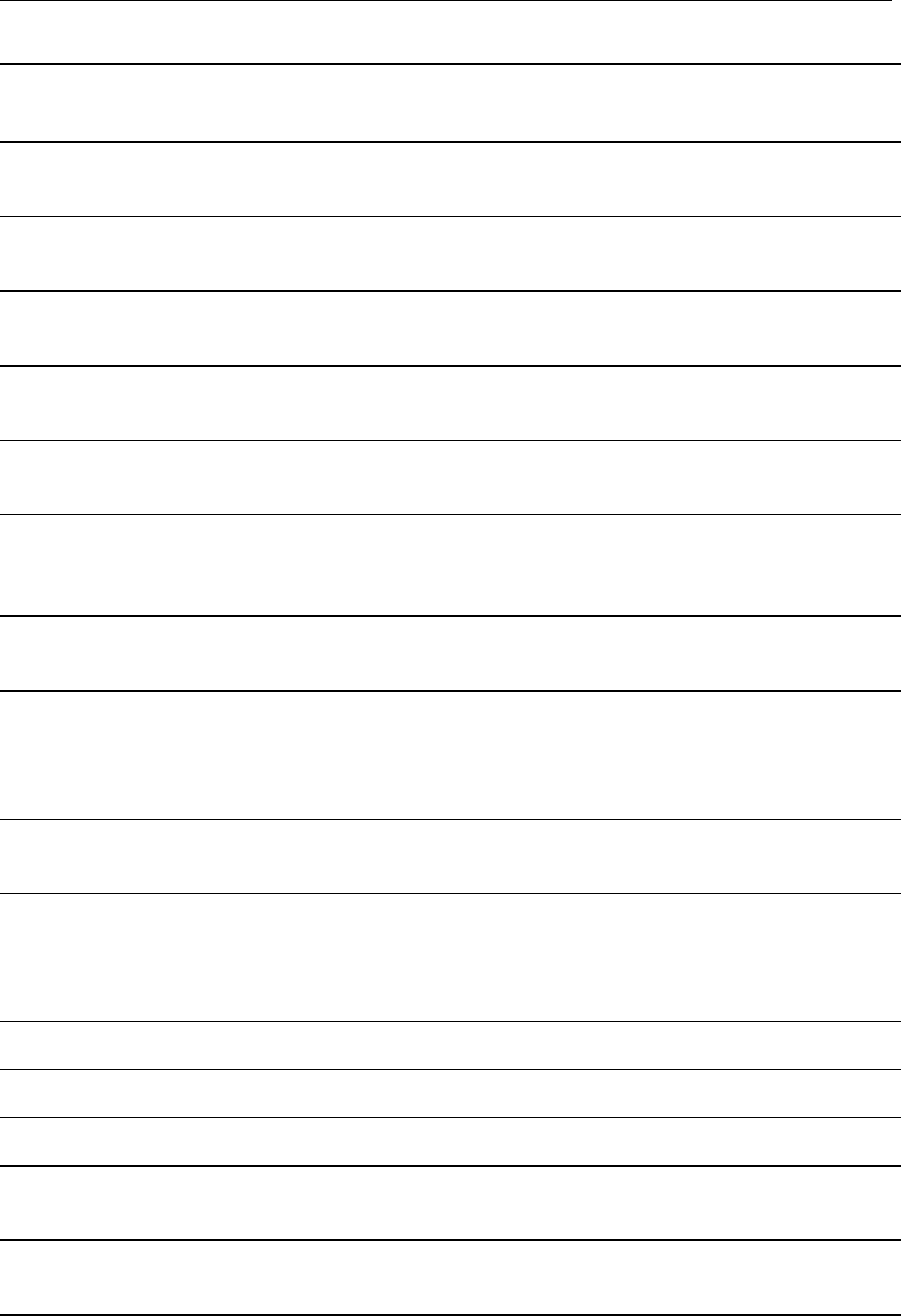
Appendix D: Channel List 101
68 156.425 156.425 All areas Intership, Ship/Shore and Non-commercial:
For marinas and yacht clubs.
69 156.475 156.475 All areas
except EC
Intership, Ship/Shore, Commercial and Non-commercial
69 156.475 156.475 EC Intership, Ship/Shore and Commercial:
Commercial fishing only.
71 156.575 156.575 PC Intership, Ship/Shore, Commercial, Non-commercial,
Safety and Ship Movement
71 156.575 156.575 Intership, Ship/Shore and Non-commercial: For marinas
and yacht clubs on the East Coast and on Lake Winnipeg.
72 156.625 156.625 EC, PC Intership, Commercial and Non-commercial:
May be used to communicate with aircraft and helicopters
in predominantly maritime support operations.
73 156.675 156.675 EC Intership, Ship/Shore and Commercial:
Commercial fishing only
73 156.675 156.675 All areas
except EC
Intership, Ship/Shore, Commercial, Non-commercial,
Safety: May also be used for communications with aircraft
engaged in coordinated search and rescue and antipollu-
tion operations.
74 156.725 156.725 EC, PC Intership, Ship/Shore, Commercial, Non-commercial and
Ship Movement.
77 156.875 156.875 Intership, Ship/Shore, Safety and Ship Movement:
Pilotage on Pacific Coast. Port operations only in the St.
Lawrence River/Great Lakes areas with 1W maximum
power.
78A 156.925 156.925 EC, PC Intership, Ship/Shore and Commercial
79A 156.975 156.975 EC, PC Intership, Ship/Shore and Commercial
80A 157.025 157.025 EC, PC Intership, Ship/Shore and Commercial
81A 157.075 157.075 Intership and Ship/Shore: Canadian Coast Guard use only
in the St. Lawrence River/Great Lakes areas.
81A 157.075 157.075 PC Intership, Ship/Shore and Safety:
Canadian Coast Guard antipollution.
CH
No.
XMIT
Freq
RCV
Freq
Area of
Operation Use
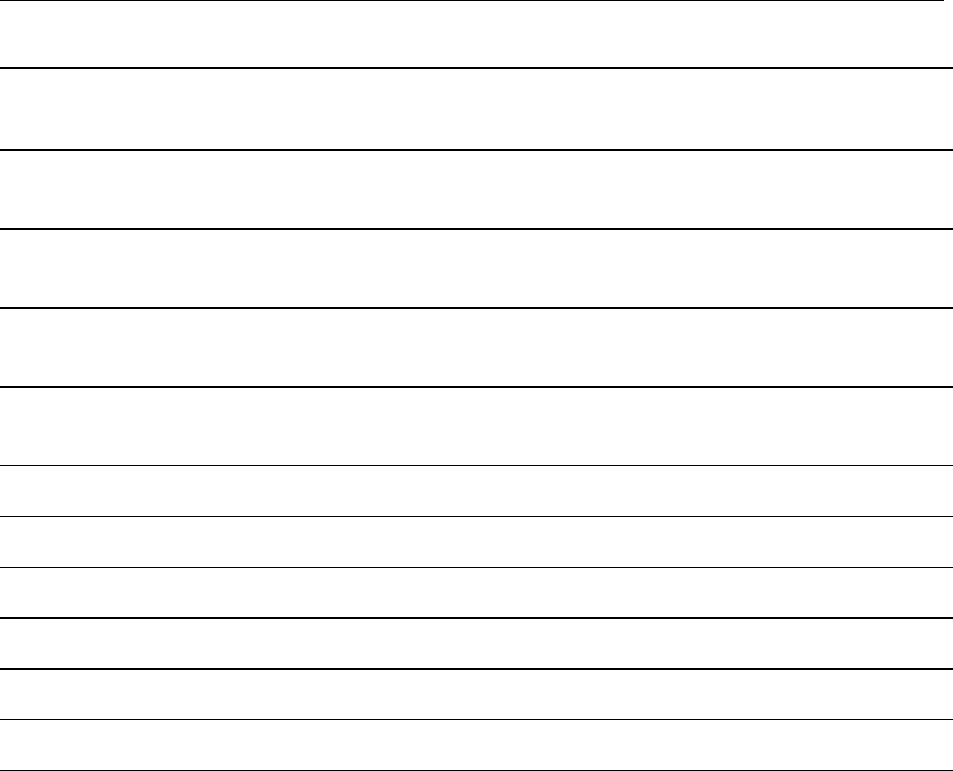
102 Ray49 Marine VHF Radio
Area of Operation
AC: Atlantic Coast, Gulf and St. Lawrence River up to and including Montreal
EC (East Coast): includes NL, AC, GL and Eastern Arctic areas
GL: Great Lakes (including St. Lawrence above Montreal)
NL: Newfoundland and Labrador
PC: Pacific Coast
WC (West Coast): Pacific Coast, Western Arctic and Athabasca-Mackenzie Watershed areas
All areas: includes East and West Coast areas
Notes:
1. An “A” following a channel number indicates simplex use of the ship station transmit side of an interna-
tional duplex channel. Operations are different from that of international operations on that channel.
2. Channel 16 is used for calling other stations or for distress alerting.
3. The letter “B” following a channel number indicates simplex use of the coast station transmit side of an
international duplex channel. That is, the channel is Receive Only.
4. Channel 70 is used exclusively for Digital Selective Calling (DSC) and is not available for regular voice
communications.
5. Channels 75 and 76 are reserved as guard bands for Channel 16 and are not available for regular voice
communications.
82A 157.125 157.125 PC Intership, Ship/Shore and Safety:
Canadian Coast Guard use only.
82A 157.125 157.125 Intership and Ship/Shore: Canadian Coast Guard use only
in the St. Lawrence River/Great Lakes areas.
83 157.175 161.775 PC Ship/Shore and Safety:
Canadian Coast Guard use only.
83A 157.175 157.175 EC Intership and Ship/Shore:
Canadian Coast Guard and other Government agencies.
83B - 161.775 AC, GL Safety: Continuous Marine Broadcast (CMB) Service.
84 157.225 161.825 PC Ship/Shore and Public Correspondence
85 157.275 161.875 AC, GL, NL Ship/Shore and Public Correspondence
86 157.325 161.925 PC Ship/Shore and Public Correspondence
87 157.375 161.975 AC, GL, NL Ship/Shore and Public Correspondence
88 157.425 162.025 AC, GL, NL Ship/Shore and Public Correspondence
CH
No.
XMIT
Freq
RCV
Freq
Area of
Operation Use
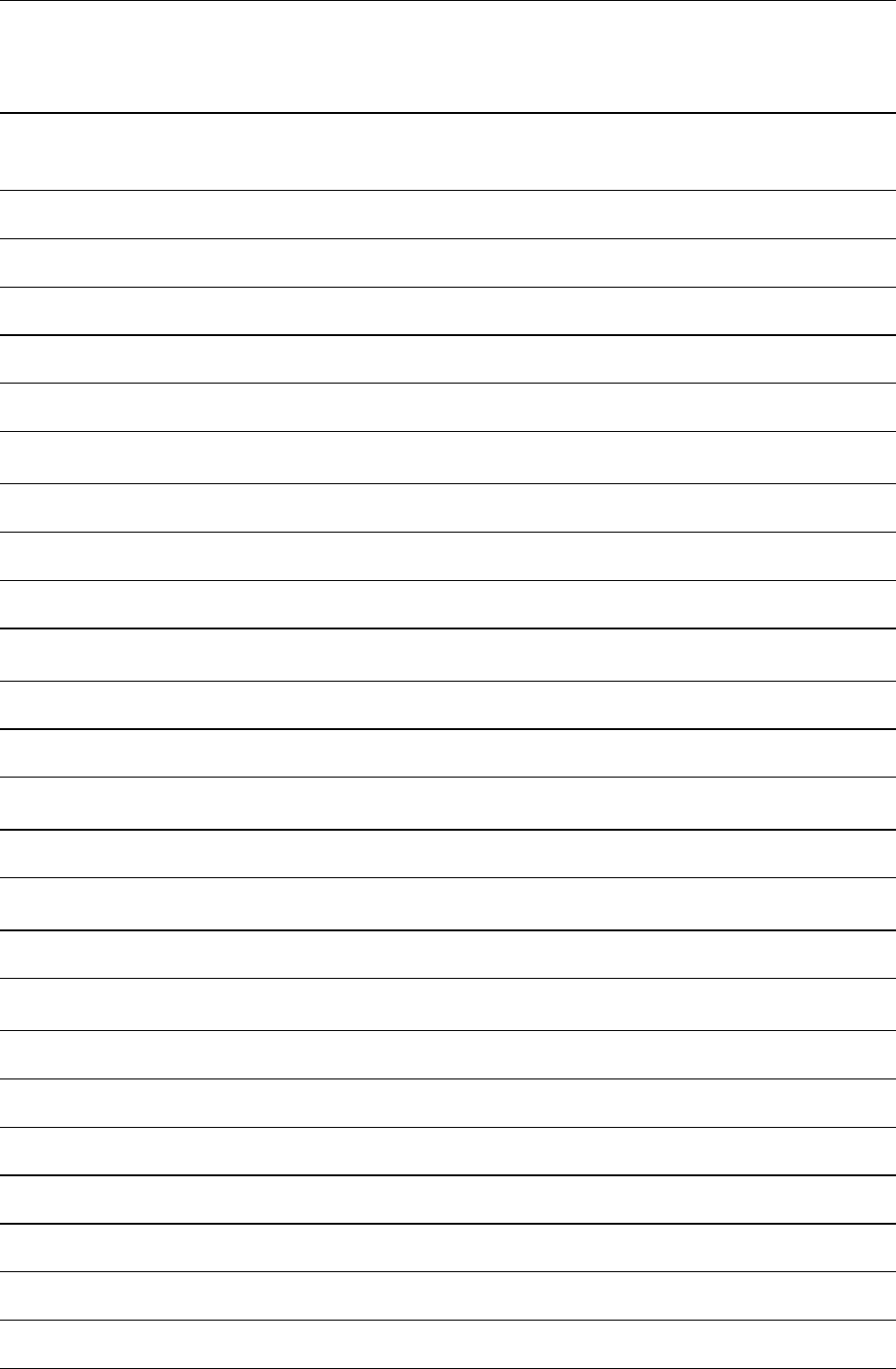
Appendix D: Channel List 103
International Marine VHF Channels & Frequencies
CH
No.
XMIT
Freq
RCV
Freq
Single
Freq Use
01 156.050 160.650 Public Correspondence, Port Operations and Ship Movement
02 156.100 160.700 Public Correspondence, Port Operations and Ship Movement
03 156.150 160.750 Public Correspondence, Port Operations and Ship Movement
04 156.200 160.800 Public Correspondence, Port Operations and Ship Movement
05 156.250 160.850 Public Correspondence, Port Operations and Ship Movement
06 156.300 156.300 x Intership 1
07 156.350 160.950 Public Correspondence, Port Operations and Ship Movement
08 156.400 156.400 x Intership
09 156.450 156.450 x Intership, Port Operations and Ship Movement
10 156.500 156.500 x Intership, Port Operations and Ship Movement 2
11 156.550 156.550 x Port Operations and Ship Movement
12 156.600 156.600 x Port Operations and Ship Movement
13 156.650 156.650 x Intership Safety, Port Operations and Ship Movement 3
14 156.700 156.700 x Port Operations and Ship Movement
15 156.750 156.750 x Intership and On-board Communications at 1W only 4
16 156.800 156.800 x Distress, Safety and Calling
17 156.850 156.850 x Intership and On-board Communications at 1W only 4
18 156.900 161.500 Public Correspondence, Port Operations and Ship Movement
19 156.950 161.550 Public Correspondence, Port Operations and Ship Movement
20 157.000 161.600 Public Correspondence, Port Operations and Ship Movement
21 157.050 161.650 Public Correspondence, Port Operations and Ship Movement
22 157.100 161.700 Public Correspondence, Port Operations and Ship Movement
23 157.150 161.750 Public Correspondence, Port Operations and Ship Movement
24 157.200 161.800 Public Correspondence, Port Operations and Ship Movement
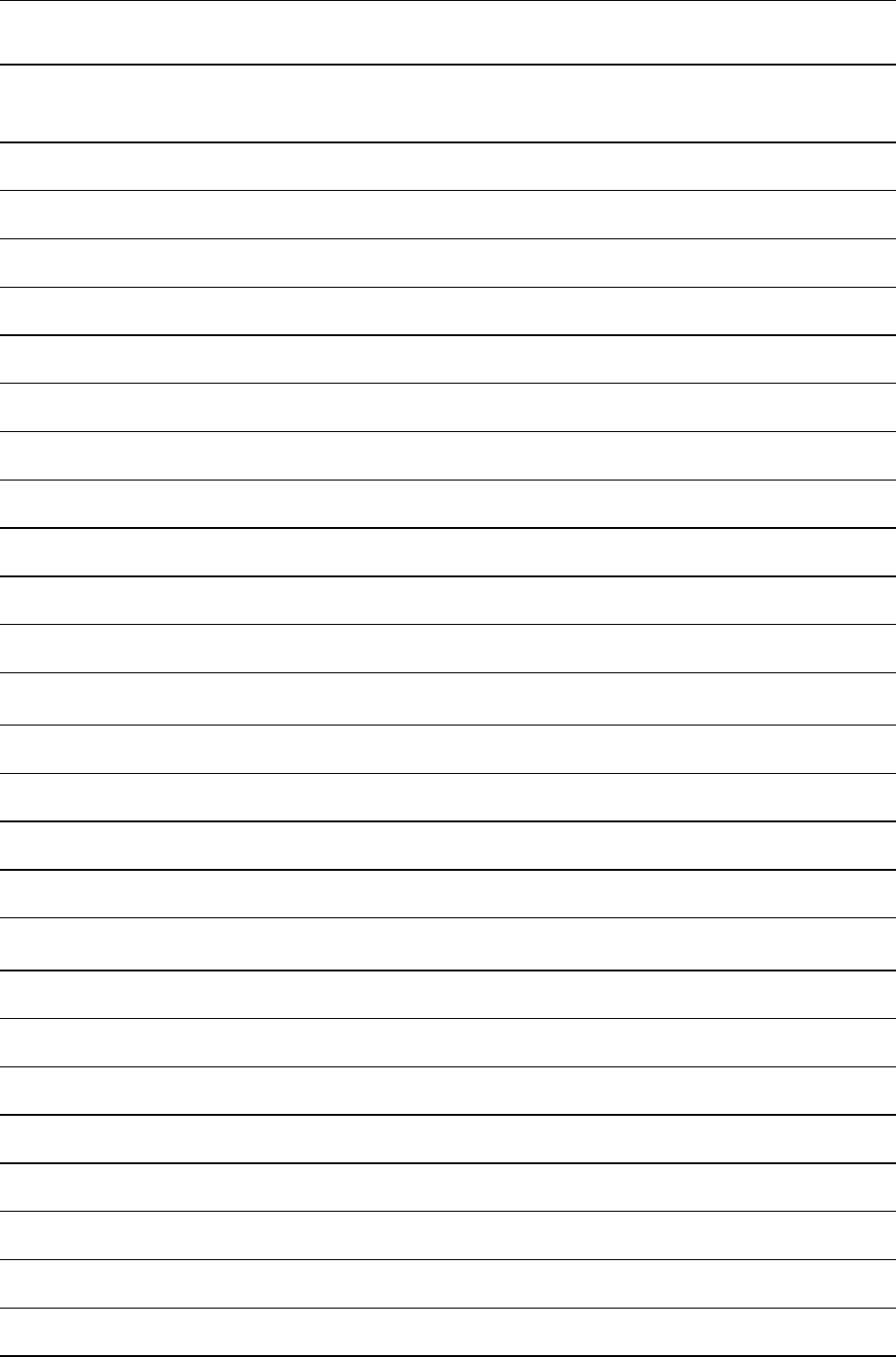
104 Ray49 Marine VHF Radio
25 157.250 161.850 Public Correspondence, Port Operations and Ship Movement
26 157.300 161.900 Public Correspondence, Port Operations and Ship Movement
27 157.350 161.950 Public Correspondence, Port Operations and Ship Movement
28 157.400 162.000 Public Correspondence, Port Operations and Ship Movement
60 156.025 160.625 Public Correspondence, Port Operations and Ship Movement
61 156.075 160.675 Public Correspondence, Port Operations and Ship Movement
62 156.125 160.725 Public Correspondence, Port Operations and Ship Movement
63 156.175 160.775 Public Correspondence, Port Operations and Ship Movement
64 156.225 160.825 Public Correspondence, Port Operations and Ship Movement
65 156.275 160.875 Public Correspondence, Port Operations and Ship Movement
66 156.325 160.925 Public Correspondence, Port Operations and Ship Movement
67 156.375 156.375 x Intership, Port Operations and Ship Movement 2
68 156.425 156.425 x Port Operations and Ship Movement
69 156.475 156.475 x Intership, Port Operations and Ship Movement
71 156.575 156.575 x Port Operations and Ship Movement
72 156.625 156.625 x Intership
73 156.675 156.675 x Intership 2
74 156.725 156.725 x Port operations and Ship movement
75 156.775 156.775 x See Note 5
76 156.825 156.825 x See Note 5
77 156.875 156.875 x Intership
78 156.925 161.525 Public correspondence, Port Operations and Ship Movement
79 156.975 161.575 Public correspondence, Port Operations and Ship Movement
80 157.025 161.625 Public correspondence, Port Operations and Ship Movement
81 157.075 161.675 Public correspondence, Port Operations and Ship Movement
CH
No.
XMIT
Freq
RCV
Freq
Single
Freq Use
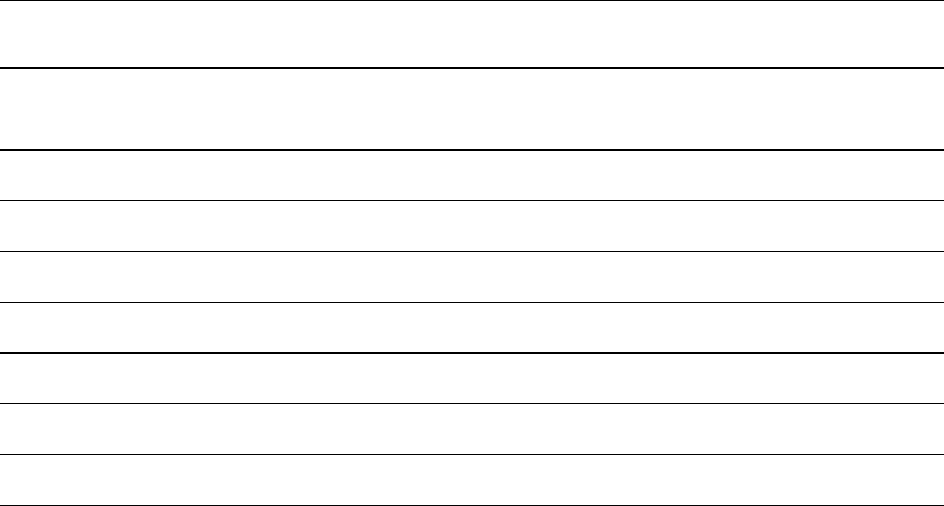
Appendix D: Channel List 105
• Intership channels are for communications between ship stations. Intership communications
should be restricted to Channels 6, 8, 72 and 77. If these are not available, the other channels
marked for Intership may be used.
• Channel 70 is used exclusively for Digital Selective Calling (DSC) and is not available for regular
voice communications.
Notes:
1. Channel 06 may also be used for communications between ship stations and aircraft engaged in
coordinated search and rescue operations. Ship stations should avoid harmful interference to such
communications on channel 06 as well as to communications between aircraft stations, ice break-
ers and assisted ships during ice seasons.
2. Within the European Maritime Area and in Canada, channels 10, 67 and 73 may also be used by
the individual administrations concerned for communication between ship stations, aircraft sta-
tions and participating land stations engaged in coordinated search and rescue and anti-pollu-
tion operations in local areas. Channels 10 or 73 (depending on location) are also used for the
broadcast of Marine Safety Information by the Maritime and Coast Guard Agency in the UK only.
3. Channel 13 is designated for use on a worldwide basis as a navigation safety communication chan-
nel, primarily for intership navigation safety communications.
4. Channels 15 and 17 may also be used for on-board communications provided the effective radiated
power does not exceed 1 Watt.
5. The use of Channels 75 and 76 should be restricted to navigation related communication only and
all precautions should be taken to avoid harmful interference to channel 16. Transmit power is lim-
ited to 1 Watt.
82 157.125 161.725 Public correspondence, Port Operations and Ship Movement
83 157.175 161.775 Public correspondence, Port Operations and Ship Movement
84 157.225 161.825 Public correspondence, Port Operations and Ship Movement
85 157.275 161.875 Public correspondence, Port Operations and Ship Movement
86 157.325 161.925 Public correspondence, Port Operations and Ship Movement
87 157.375 157.375 x Port Operations and Ship Movement
88 157.425 157.425 x Port Operations and Ship Movement
CH
No.
XMIT
Freq
RCV
Freq
Single
Freq Use
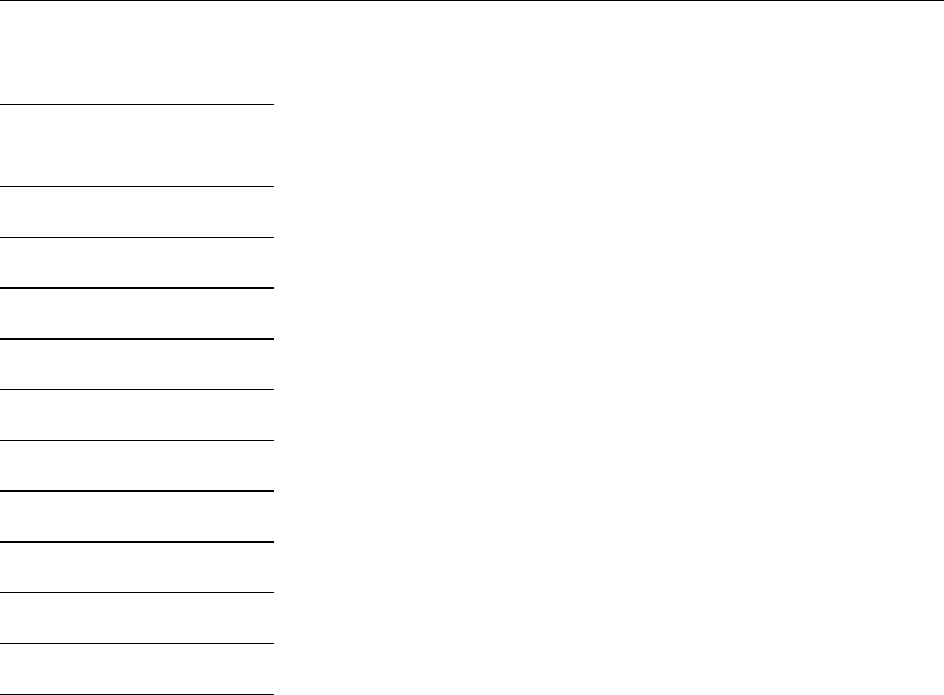
106 Ray49 Marine VHF Radio
WX Channels (North America only)
Weather
Channel
Frequency
in MHz
WX 1 162.550
WX 2 162.400
WX 3 162.475
WX 4 162.425
WX 5 162.450
WX 6 162.500
WX 7 162.525
WX 8 161.650
WX 9 161.775
WX 10 163.275

107
Appendix E: Glossary
Term Meaning
All Scan A feature that scans all channels in the channel set.
All Ships Call A DSC call that sends out a message to all vessels within range.
The Ray49 can make two different types of All Ships calls: Safety
Calls for advisory alerts or Urgency Calls when assistance is
required but there is no imminent danger to the vessel.
Canadian Channels Channel designations as defined by Industry Canada.
CH Channel selection key
COG Course Over Ground
Distress Call A DSC call notifying other ships and shore stations that your
vessel is in imminent danger, sending your position and time
information, along with (optionally) the nature of your distress
situation.
DSC Digital Selective Calling (DSC) is a system used to send digital
messages to stations identified by a unique MMSI number. Con-
tained within the message is the working channel on which
voice communications are to be made. DSC enables you to
make digital Distress Calls and to specify the stations that you
wish to contact: an Individual station, all stations within a spec-
ified Group, or All Ship stations within range.
Dual Watch A feature that monitors the Priority Channel 16 and one other
channel that you choose.
FCC Federal Communications Commission (US)
Global Positioning
System
A navigational system that uses satellite signals to determine
the latitude and longitude of a receiver on Earth.
GPS Global Positioning System
Group Call A DSC call that sends transmissions only received by radios
sharing a common Group MMSI number, such as a flotilla or
racing fleet.
Individual Call A DSC Call made to a specific station identified by its MMSI
number.
International Channels Channel designations as defined by the ITU
ITU International Telecommunications Union (EU)

108 Ray49 Marine VHF Radio
MMSI Maritime Mobile Service Identity; a number issued by each
country to identify maritime stations, much like a telephone
number.
NOAA National Oceanographic and Atmospheric Administration (US)
Position Request A DSC call requesting GPS position information from any
station for which an MMSI number is known. You can also send
out your position to other stations.
Priority Channel Channel 16 or 9
Priority Scan A feature that alternates monitoring the Priority Channel 16
with each of the regular channels.
PTT switch Microphone push-to-talk switch
RF Radio Frequency
RX Receive
SAR Search And Rescue
Saved Scan Scans only user-selected memory channels
Semi-duplex Channels using separate frequencies to transmit and receive.
Simplex Channels transmitting and receiving on the same frequency.
SOG Speed Over Ground
Squelch A circuit that sets the threshold for cutting off the receiver when
the signal is too weak for reception of anything but noise.
TX Transmit
Tri Watch A function that monitors the Priority Channel (16), the Second-
ary Priority Channel, and one other channel that you choose.
USA Channels Channel designations as defined by the FCC
VOL Volume key
VHF Very High Frequency (30MHz to 300MHz)
Weather (WX)
Channels
Channels for routine and emergency weather information
broadcast by NOAA (USA)
WX Weather Band key
Working Channel The currently-selected (non-priority, non-WX) channel
Term Meaning

109
Index
Numerics
16/9 key 23,25
A
Accessories 88
Adding channels to memory 42
All Scan function 38
All Ships Calls 74
Receiving 74
Transmitting 74
ATIS
indicator 28
Automatic Channel Changing 26,84
B
Backlight adjustment 51
Bearing Mode 53
C
Cable connections 19
Canadian channels 27,98
Channel
Knob 24
Name 45
Tuning 28
UP/DOWN key 24
Channel List 95
Canadian frequencies 98
International frequencies 103
US frequencies 95
WX frequencies 106
CLR/WX key 25
Coast Stations 66
COG/SOG Display 50
Connections
cable 19
external speaker 20
GPS 20
NMEA 20
power 20
Contrast adjustment 52
Conventions 9
Customer Support 87
D
Deleting channels from memory 42
Display 25
Distress Calls 59
key 25
Receiving 62
Receiving Distress Relay 63
Sending a Designated call 60
Sending an Undesignated (QUICK) call 59
DSC 57
All Ships Calls 74
Call icon 26
Distress Calls 59
Group Calls 70
Individual Calls 66
key 35
Log 79
Options 81
Menu 24,57
Phonebook 64
DSC Settings
Automatic Channel Changing 84
Group MMSI Setup 70
My MMSI ID 81
Position Reply 85
Dual Watch 25,44
E
External speaker 20
F
Features 13
Frequency Band 45
Canadian channels 98
International channels 103
US channels 95
WX channels 106
G
Glossary 107
GPS
indicator 26
Installing 20
Position Reply 85
setup 47

110 Ray49 Marine VHF Radio
Group Calls 70
Receiving 73
Transmitting 71
Group MMSI Setup 70
H
Handset 23,91
Help from Raymarine 87
HI/LO
indicator 27
key 23
power selection 40
High Voltage 20
I
Individual Calls 66
Receiving 69
Transmitting 67
Installation 15
International channels 27,103
Invalid Channel 69,73,76
K
Key Beep 53
Keypad 91
Keys 23
L
Last Received Position Request 78
Latitude/Longitude Display 50
LCD display 25
Local Mode 26,47
Log 79
Options 81
Low Voltage 20
M
Memory
Adding channels to 42
Menu 24,35
DSC Setup 81
GPS/Time Setup 47
Phonebook 64
Adding entries 64
Deleting entries 66
Editing entries 66
Settings 49
MENU/DSC key 24,35,57
Messages 79
Microphone 23,35,58,91
MMSI 81
Monitor Mode
Dual Watch 44
Tri Watch 44
My MMSI ID 81
N
NMEA connections 20
NMEA Out 51
O
Override low power restriction 32,41
P
Phonebook 64
Adding entries 64
Deleting entries 66
Editing entries 66
PLUS channel 30
Position Reply 85
Position Request 77
from Phonebook 77
receiving from another station 78
retrieving last received 78
Power 24
connections 20
ON/OFF 28
selection 40
Priority Channel 30
Priority Saved Scan function 40
Priority Scan function 39
PTT key 23,32
PWR/VOL key 24
R
Radio Setup
Channel Name 45
Frequency Band 45
Sensitivity 47
Raymarine
Addresses 87
Phone numbers 87
Web site 87
Received Calls 79

111
Removing the sun cover 15
Repair 87
Reset 55
RX indicator 26
S
Save 24
SAVED indicator 26
Saved Scan function 39
Scan Mode 37
All Scan 38
Priority All Scan 39
Priority Saved Scan 40
Saved Scan 39
SCAN/SAVE key 24
Secondary Priority (PLUS) Channel 30
Sensitivity 47
Service 87
Settings 49,81
COG/SOG Display 50
Latitude/Longitude Display 50
Time Display 50
Time Format 50
Time Offset 50
Speaker 20
Specifications 89
Speed Unit 54
Squelch 24,28
Standard equipment 16,19
Sun cover removal 15
System Configuration 51
Backlight 51
Bearing Mode 53
Contrast 52
Key Beep 53
Reset 55
Speed Unit 54
System Test 54
Version Number 55
System Test 54
T
Technical Support 88
Time
Display 50
Format 50
Offset 50
Setup 47
Transmitting 32
Override 32,41
Tri Watch 25,44
TX 26,32
U
Unable to Comply 69,73,76
US channels 27,95
UTC time setup 47
V
Version Number 55
Voltage 20
Volume 24,28
W
Warranty 9
Weather Alert 26,27,29
Weather channels 29,106
Web site 87
Wire connections 19
WX 29,106

112 Ray49 Marine VHF Radio